The Chemical Level of Organization
2.0 Introduction

Chapter Goals
After learning this chapter, it is possible for you to to:
- Describe the basic composition of matter
- Determine the three subatomic particles
- Determine the 4 most plentiful components within the physique
- Clarify the connection between an atom’s variety of electrons and its relative stability
- Distinguish between ionic bonds, covalent bonds, and hydrogen bonds
- Clarify how power is invested, saved, and launched through chemical reactions, notably these reactions which are essential to life
- Clarify the significance of the inorganic compounds that contribute to life, akin to water, salts, acids, and bases
- Evaluate and distinction the 4 necessary lessons of natural (carbon-based) compounds—proteins, carbohydrates, lipids and nucleic acids—in accordance with their composition and purposeful significance to human life
The smallest, most basic materials parts of the human physique are primary chemical components. In reality, chemical compounds referred to as nucleotide bases are the inspiration of the genetic code with the directions on how you can construct and keep the human physique from conception by way of previous age. There are about three billion of those base pairs in human DNA.
Human chemistry contains natural molecules (carbon-based) and biochemicals (these produced by the physique). Human chemistry additionally contains components. In reality, life can’t exist with out lots of the components which are a part of the earth. All the components that contribute to chemical reactions, to the transformation of power, and to electrical exercise and muscle contraction—components that embrace phosphorus, carbon, sodium, and calcium, to call just a few—originated in stars.
These components, in flip, can kind each the inorganic and natural chemical compounds necessary to life, together with, water, glucose, and proteins. This chapter begins by inspecting components and the way the constructions of atoms, the essential models of matter, decide the traits of components by the variety of protons, neutrons, and electrons within the atoms. The chapter then builds the framework of life from there.
2.1 Parts and Atoms: The Constructing Blocks of Matter
Studying Goals
By the top of this part, it is possible for you to to:
- Talk about the relationships between matter, mass, components, compounds, atoms, and subatomic particles
- Distinguish between atomic quantity and mass quantity
- Determine the important thing distinction between isotopes of the identical factor
- Clarify how electrons occupy electron shells and their contribution to an atom’s relative stability
The substance of the universe—from a grain of sand to a star—is named matter. Scientists outline matter as something that occupies house and has mass. An object’s mass and its weight are associated ideas, however not fairly the identical. An object’s mass is the quantity of matter contained within the object, and is identical whether or not that object is on Earth or within the zero-gravity atmosphere of outer house. An object’s weight, then again, is its mass as affected by the pull of gravity. An object’s weight is bigger the place the pull of gravity is stronger than the place the gravity is much less sturdy. For instance, an object of a sure mass weighs much less on the moon than it does on Earth as a result of the gravity of the moon is lower than that of Earth. In different phrases, weight is variable, and is influenced by gravity. A chunk of cheese that weighs a pound on Earth weighs just a few ounces on the moon.
Parts and Compounds
All matter within the pure world consists of a number of of the 92 basic substances referred to as components. An factor is a pure substance that’s distinguished from all different matter by the truth that it can’t be created or damaged down by strange chemical means. Whereas your physique can assemble lots of the chemical compounds wanted for all times from their constituent components, it can’t make components. They need to come from the atmosphere. A well-known instance of a component that you should absorb is calcium (Ca++). Calcium is important to the human physique; it’s absorbed and used for quite a few processes, together with strengthening bones. While you eat dairy merchandise your digestive system breaks down the meals into parts sufficiently small to cross into the bloodstream. Amongst these is calcium, which, as a result of it is a component, can’t be damaged down additional. The basic calcium in cheese, due to this fact, is identical because the calcium that kinds your bones. Another components you could be acquainted with are oxygen, sodium, and iron. The weather within the human physique are proven in Figure 2.1.1, starting with probably the most plentiful: oxygen (O), carbon (C), hydrogen (H), and nitrogen (N). Every factor’s title could be changed by a one- or two-letter image; you’ll change into acquainted with a few of these throughout this course. All the weather in your physique are derived from the meals you eat and the air you breathe.
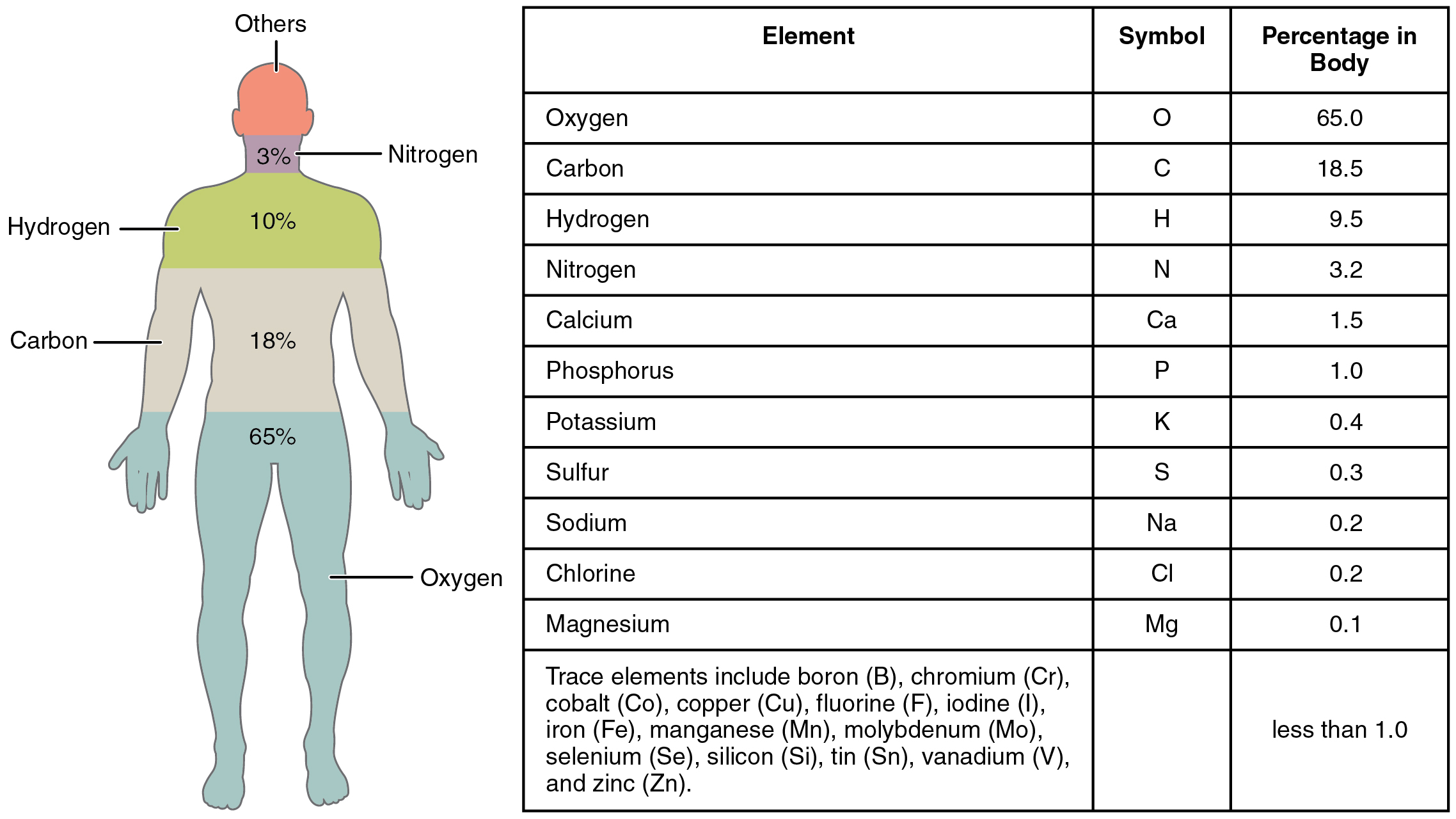
In nature, components not often happen alone. As an alternative, they mix to kind compounds. A compound is a substance composed of two or extra components joined by chemical bonds. For instance, the compound glucose is a vital physique gas. It’s at all times composed of the identical three components: carbon, hydrogen, and oxygen. Furthermore, the weather that make up any given compound at all times happen in the identical relative quantities. In glucose, there are at all times six carbon and 6 oxygen models for each twelve hydrogen models. However what, precisely, are these “models” of components?
Atoms and Subatomic Particles
An atom is the smallest amount of a component that retains the distinctive properties of that factor. In different phrases, an atom of hydrogen is a unit of hydrogen—the smallest quantity of hydrogen that may exist. As you would possibly guess, atoms are virtually unfathomably small. The interval on the finish of this sentence is thousands and thousands of atoms vast.
Atomic Construction and Vitality
Atoms are made up of even smaller subatomic particles, which embrace three necessary sorts: the proton, neutron, and electron. The variety of positively-charged protons and non-charged (“impartial”) neutrons, provides mass to the atom, and the variety of every within the nucleus of the atom determines the factor. The variety of negatively-charged electrons that “spin” across the nucleus at near the velocity of sunshine equals the variety of protons. An electron has about 1/2000th the mass of a proton or neutron.
Determine 2.1.2 exhibits two fashions that may make it easier to think about the construction of an atom—on this case, helium (He). Within the planetary mannequin, helium’s two electrons are proven circling the nucleus in a hard and fast orbit depicted as a hoop. Though this mannequin is useful in visualizing atomic construction, in actuality, electrons don’t journey in fastened orbits, however whiz across the nucleus erratically in a so-called electron cloud.
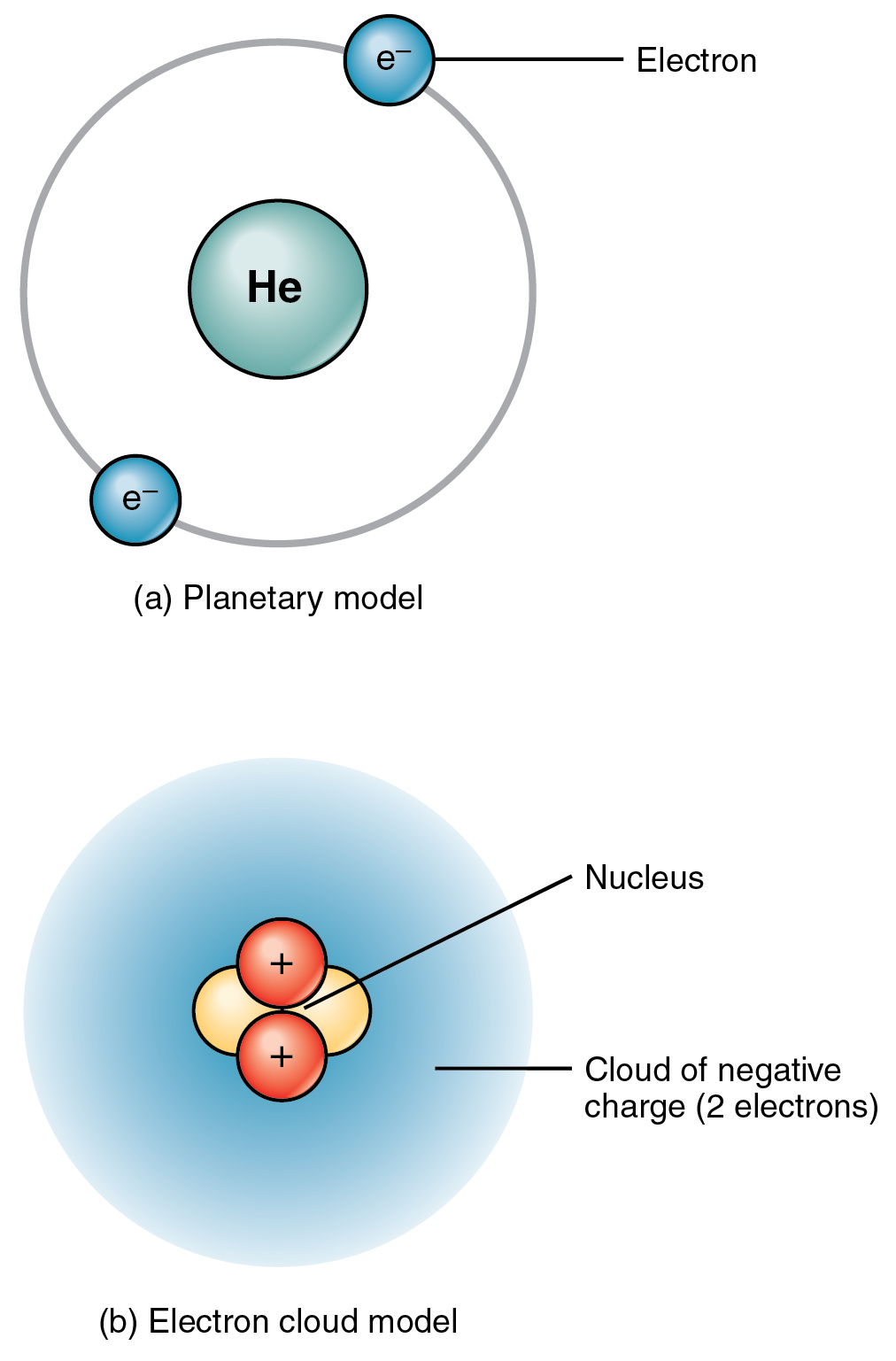
An atom’s protons and electrons carry electrical prices. Protons, with their constructive cost, are designated p+. Electrons, which have a unfavorable cost, are designated e–. An atom’s neutrons haven’t any cost: they’re electrically impartial. Simply as a magnet sticks to a metal fridge as a result of their reverse prices appeal to, the positively charged protons appeal to the negatively charged electrons. This mutual attraction provides the atom some structural stability. The attraction by the positively charged nucleus helps preserve electrons from straying far. The variety of protons and electrons inside a impartial atom are equal, thus, the atom’s general cost is balanced.
Atomic Quantity and Mass Quantity
An atom of carbon is exclusive to carbon, however a proton of carbon will not be. One proton is identical as one other, whether or not it’s present in an atom of carbon, sodium (Na), or iron (Fe). The identical is true for neutrons and electrons. So, what provides a component its distinctive properties—what makes carbon so totally different from sodium or iron? The reply is the distinctive amount of protons every incorporates. Carbon by definition is a component whose atoms include six protons. No different factor has precisely six protons in its atoms. Furthermore, all atoms of carbon, whether or not present in your liver or in a lump of coal, include six protons. Thus, the atomic quantity, which is the variety of protons within the nucleus of the atom, identifies the factor. Since an atom normally has the identical variety of electrons as protons, the atomic quantity identifies the standard variety of electrons as nicely.
Of their most typical kind, many components additionally include the identical variety of neutrons as protons. The commonest type of carbon, for instance, has six neutrons in addition to six protons, for a complete of 12 subatomic particles in its nucleus. A component’s mass quantity is the sum of the variety of protons and neutrons in its nucleus. So the most typical type of carbon’s mass quantity is 12. Electrons have so little mass that they don’t appreciably contribute to the mass of an atom. Carbon is a comparatively gentle factor; Uranium (U), in distinction, has a mass variety of 238 and is known as a heavy metallic. Its atomic quantity is 92 (it has 92 protons) but it surely incorporates 146 neutrons; it has probably the most mass of all of the naturally occurring components.
The periodic desk of the weather, proven in Determine 2.1.3, is a chart figuring out the 92 components present in nature, in addition to a number of bigger, unstable components found experimentally. The weather are organized so as of their atomic quantity, with hydrogen and helium on the high of the desk, and the extra large components beneath. The periodic desk is a helpful system as a result of for every factor, it identifies the chemical image, the atomic quantity, and the mass quantity, whereas organizing components in accordance with their propensity to react with different components. The variety of protons and electrons in a component are equal. The variety of protons and neutrons could also be equal for some components, however should not equal for all.
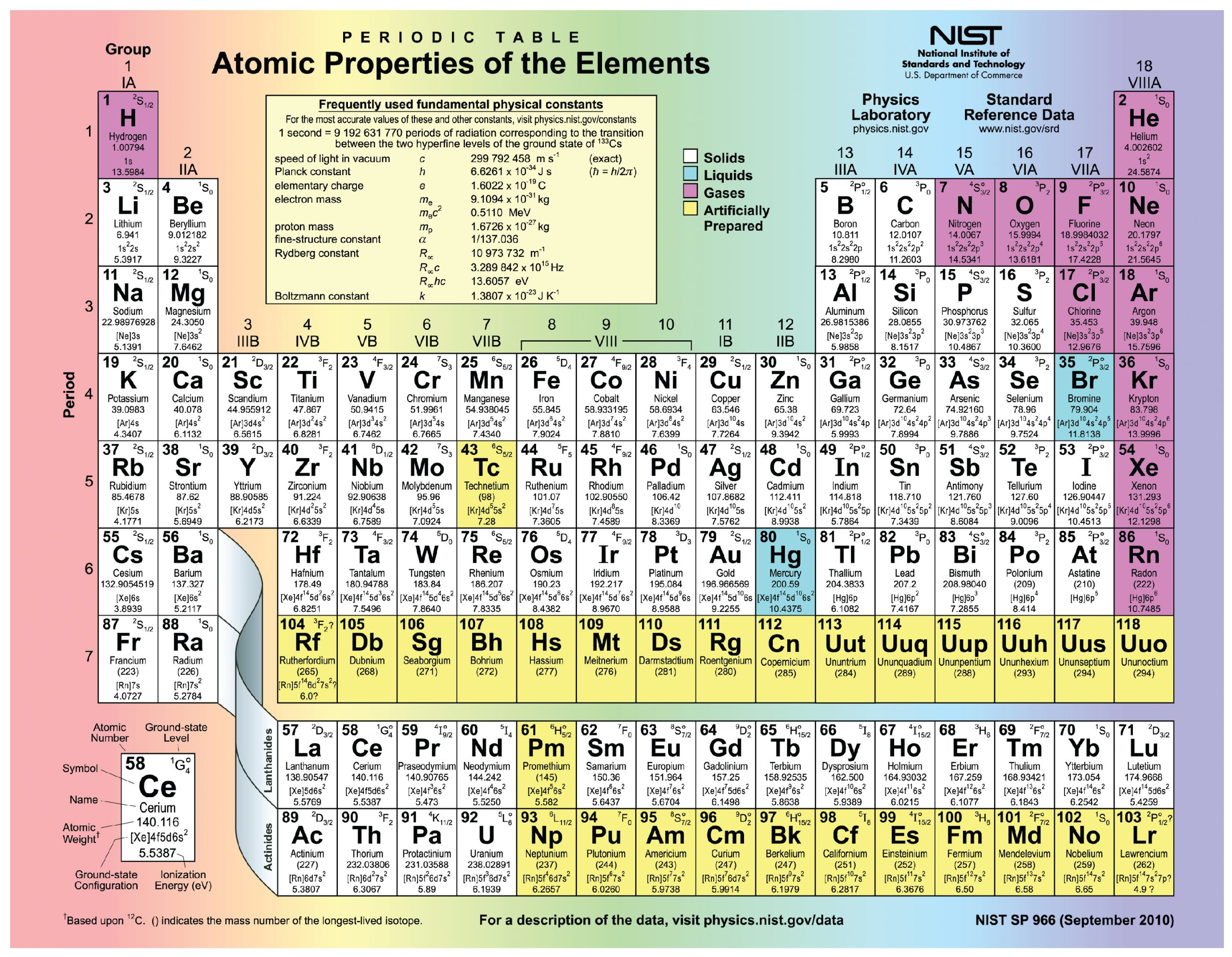
Isotopes
Though every factor has a novel variety of protons, it may exist as totally different isotopes. An isotope is among the totally different types of a component, distinguished from each other by totally different numbers of neutrons. The usual isotope of carbon is 12C, generally referred to as carbon twelve. 12C has six protons and 6 neutrons, for a mass variety of twelve. All the isotopes of carbon have the identical variety of protons; due to this fact, 13C has seven neutrons, and 14C has eight neutrons. The totally different isotopes of a component may also be indicated with the mass quantity hyphenated (for instance, C-12 as an alternative of 12C). Hydrogen has three widespread isotopes, proven in Determine 2.1.4.
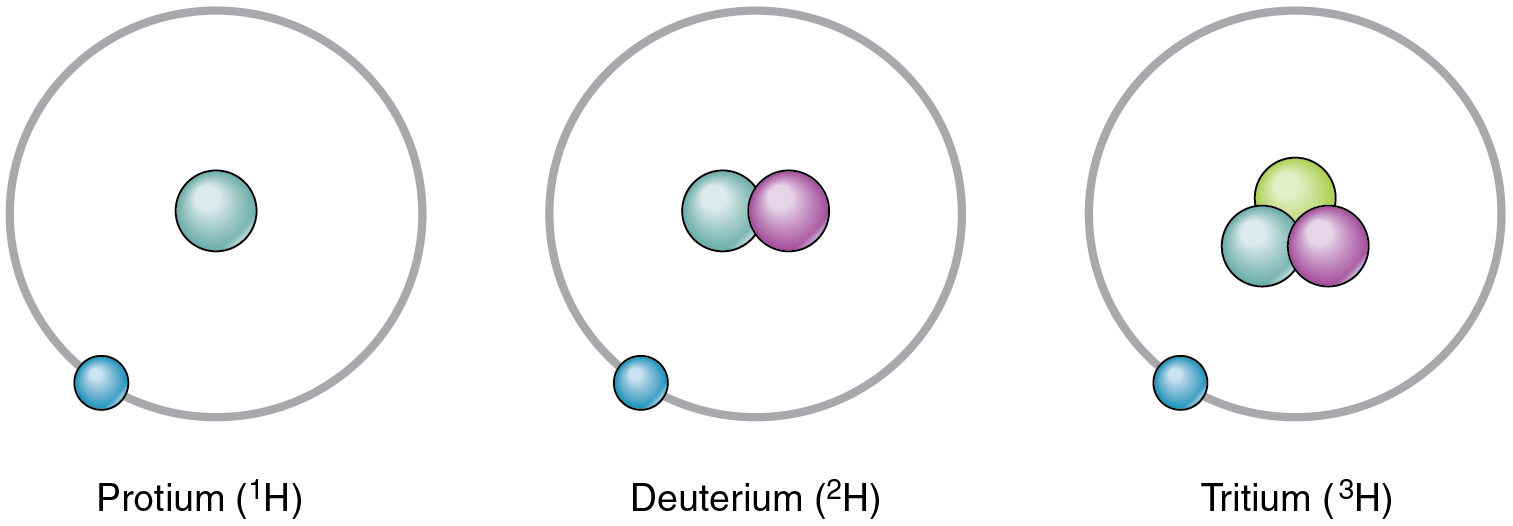
An isotope that incorporates greater than the standard variety of neutrons is known as a heavy isotope. An instance is 14C. Heavy isotopes are typically unstable, and unstable isotopes are radioactive. A radioactive isotope is an isotope whose nucleus readily decays, giving off subatomic particles and electromagnetic power. Completely different radioactive isotopes (additionally referred to as radioisotopes) differ of their half-life, the time it takes for half of any measurement pattern of an isotope to decay. For instance, the half-life of tritium—a radioisotope of hydrogen—is about 12 years, indicating it takes 12 years for half of the tritium nuclei in a pattern to decay. Extreme publicity to radioactive isotopes can injury human cells and even trigger most cancers and beginning defects, however when publicity is managed, some radioactive isotopes could be helpful in medication. For extra data, see the Profession Connections.
Profession Connections – Interventional Radiologist
The managed use of radioisotopes has superior medical analysis and remedy of illness. Interventional radiologists are physicians who deal with illness by utilizing minimally invasive methods involving radiation. Many situations that would as soon as solely be handled with a prolonged and traumatic operation can now be handled non-surgically, lowering the price, ache, size of hospital keep, and restoration time for sufferers. For instance, previously, the one choices for a affected person with a number of tumors within the liver have been surgical procedure and chemotherapy (the administration of medicine to deal with most cancers).
Some liver tumors, nevertheless, are troublesome to entry surgically, and others may require the surgeon to take away an excessive amount of of the liver; chemotherapy is very poisonous to the liver, and sure tumors don’t reply nicely to it. In some such circumstances, an interventional radiologist can deal with the tumors by disrupting their blood provide, which they want if they’re to proceed to develop. On this process, referred to as radioembolization, the radiologist accesses the liver with a high quality needle, threaded by way of one of many affected person’s blood vessels. The radiologist then inserts tiny radioactive “seeds” into the blood vessels that provide the tumors. Within the days and weeks following the process, the radiation emitted from the seeds destroys the vessels and straight kills the tumor cells within the neighborhood of the remedy.
Radioisotopes emit subatomic particles that may be detected and tracked by imaging applied sciences. One of the crucial superior makes use of of radioisotopes in medication is the positron emission tomography (PET) scanner, which detects the exercise within the physique of a really small injection of radioactive glucose, the straightforward sugar that cells use for power. The PET digicam exhibits the medical group which of the affected person’s tissues are taking over probably the most glucose. Thus, probably the most metabolically lively tissues present up as vibrant “scorching spots” on the pictures (Determine 2.1.5). PET can reveal some cancerous lots as a result of most cancers cells eat glucose at a excessive fee to gas their speedy replica.
The Habits of Electrons
Within the human physique, atoms don’t exist as impartial entities. Relatively, they’re continuously reacting with different atoms to kind and to interrupt down extra complicated substances. To totally perceive anatomy and physiology you should grasp how atoms take part in such reactions. The hot button is understanding the habits of electrons.
Though electrons don’t comply with inflexible orbits a set distance away from the atom’s nucleus, they do have a tendency to remain inside sure areas of house referred to as electron shells. An electron shell is a layer of electrons that encircle the nucleus at a definite power stage.
The atoms of the weather discovered within the human physique have from one to 5 electron shells, and all electron shells maintain eight electrons besides the primary shell, which may solely maintain two. This configuration of electron shells is identical for all atoms. The exact variety of shells is determined by the variety of electrons within the atom. Hydrogen and helium have only one and two electrons, respectively. Should you check out the periodic desk of the weather, you’ll discover that hydrogen and helium are positioned alone on both sides of the highest row; they’re the one components which have only one electron shell (Figure 2.1.6). A second shell is important to carry the electrons in all components bigger than hydrogen and helium.
Lithium (Li), whose atomic quantity is 3, has three electrons. Two of those fill the primary electron shell, and the third spills over right into a second shell. The second electron shell can accommodate as many as eight electrons. Carbon, with its six electrons, fully fills its first shell, and half-fills its second. With ten electrons, neon (Ne) fully fills its two electron shells. Once more, a have a look at the periodic desk reveals that all the components within the second row, from lithium to neon, have simply two electron shells. Atoms with greater than ten electrons require greater than two shells. These components occupy the third and subsequent rows of the periodic desk.
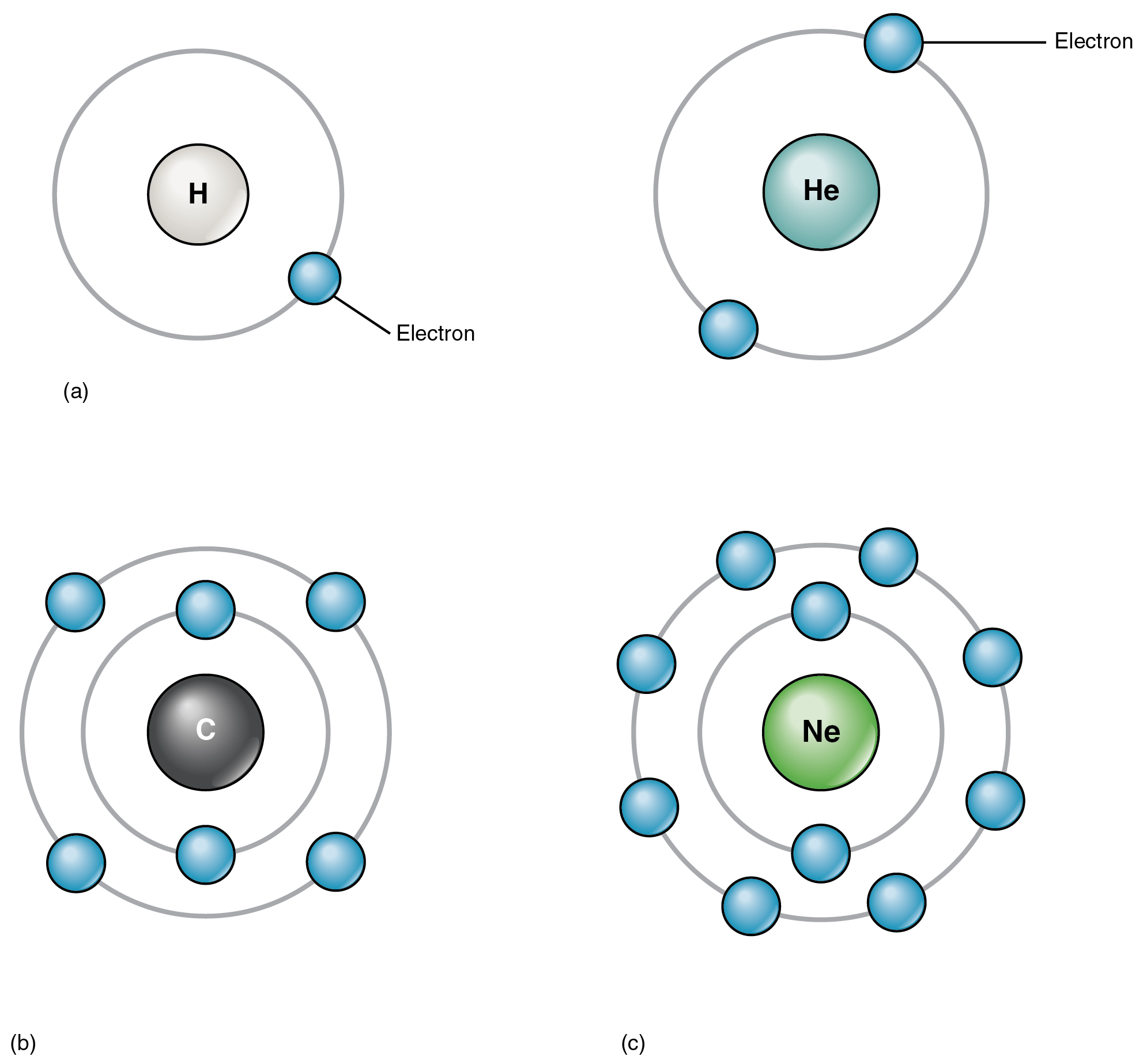
The issue that almost all strongly governs the tendency of an atom to take part in chemical reactions is the variety of electrons in its valence shell. A valence shell is an atom’s outermost electron shell. If the valence shell is full, the atom is secure, which means its electrons are unlikely to be pulled away from the nucleus by {the electrical} cost of different atoms. If the valence shell will not be full, the atom is reactive, which means it would are inclined to react with different atoms in ways in which make the valence shell full. Contemplate hydrogen, with its one electron solely half-filling its valence shell. This single electron is prone to be drawn into relationships with the atoms of different components, in order that hydrogen’s single valence shell could be stabilized.
All atoms (besides hydrogen and helium with their single electron shells) are most secure when there are precisely eight electrons of their valence shell. This precept is known as the octet rule, and it states that an atom will quit, acquire, or share electrons with one other atom in order that it finally ends up with eight electrons in its personal valence shell. For instance, oxygen, with six electrons in its valence shell, is prone to react with different atoms in a approach that ends in the addition of two electrons to oxygen’s valence shell, bringing the quantity to eight. When two hydrogen atoms every share their single electron with oxygen, covalent bonds are fashioned, leading to a molecule of water, H2O.
In nature, atoms of 1 factor have a tendency to affix with atoms of different components in attribute methods. For instance, carbon generally fills its valence shell by linking up with 4 atoms of hydrogen. In so doing, the 2 components kind the best of natural molecules—methane—which additionally is among the most plentiful and secure carbon-containing compounds on Earth. As acknowledged above, one other instance is water; oxygen wants two electrons to fill its valence shell. It generally interacts with two atoms of hydrogen, forming H2O. By the way, the title “hydrogen” displays its contribution to water (hydro- = “water”; -gen = “maker”). Thus, hydrogen is the “water maker.”
Chapter Overview
The human physique consists of components, probably the most plentiful of that are oxygen (O), carbon (C), hydrogen (H) and nitrogen (N). You get hold of these components from the meals you eat and the air you breathe. The smallest unit of a component that retains all the properties of that factor is an atom. Atoms themselves include many subatomic particles, the three most necessary of that are protons, neutrons, and electrons. These particles don’t fluctuate in high quality from one factor to a different; moderately, what provides a component its distinctive identification is the amount of its protons, referred to as its atomic quantity. Protons and neutrons contribute practically all of an atom’s mass; the variety of protons and neutrons is a component’s mass quantity. Heavier and lighter variations of the identical factor can happen in nature as a result of these variations have totally different numbers of neutrons. Completely different variations of a component are referred to as isotopes.
The tendency of an atom to be secure or to react readily with different atoms is basically as a result of habits of the electrons inside the atom’s outermost electron shell, referred to as its valence shell. Helium, in addition to bigger atoms with eight electrons of their valence shell, is unlikely to take part in chemical reactions as a result of they’re secure. All different atoms have a tendency to just accept, donate, or share electrons in a course of that brings the electrons of their valence shell to eight (or within the case of hydrogen, to 2).
2.2 Chemical Bonds
Studying Goals
By the top of this part, it is possible for you to to:
- Clarify the connection between molecules and compounds
- Distinguish between ions, cations, and anions
- Determine the important thing distinction between ionic and covalent bonds
- Distinguish between nonpolar and polar covalent bonds
- Clarify how water molecules hyperlink through hydrogen bonds
Atoms separated by an incredible distance can’t hyperlink; moderately, they need to come shut sufficient for the electrons of their valence shells to work together. However do atoms ever truly contact each other? Most physicists would say no, as a result of the negatively charged electrons of their valence shells repel each other. No drive inside the human physique—or wherever within the pure world—is powerful sufficient to beat this electrical repulsion. So whenever you examine atoms linking collectively or colliding, keep in mind that the atoms should not merging in a bodily sense.
As an alternative, atoms hyperlink by forming a chemical bond. A bond is a weak or sturdy electrical attraction that holds atoms in the identical neighborhood. The brand new grouping is often extra secure—much less prone to react once more—than its element atoms have been once they have been separate. A roughly secure grouping of two or extra atoms held collectively by chemical bonds is named a molecule. The bonded atoms could also be of the identical factor, as within the case of H2, which is named molecular hydrogen or hydrogen fuel. When a molecule is made up of two or extra atoms of various components, it’s referred to as a chemical compound. A unit of water, or H2O, is a compound, as is a single molecule of the fuel methane, or CH4.
Three varieties of chemical bonds are necessary in human physiology, as a result of they maintain collectively substances which are utilized by the physique for essential elements of homeostasis, signaling, and power manufacturing, to call just some necessary processes. These are ionic bonds, covalent bonds, and hydrogen bonds.
Ions and Ionic Bonds
Recall that an atom sometimes has the identical variety of positively charged protons and negatively charged electrons. So long as this case stays, the atom is electrically impartial. When an atom participates in a chemical response that ends in the donation or acceptance of a number of electrons, the atom will then change into positively or negatively charged. This occurs ceaselessly for many atoms with the intention to have a full valence shell, as described beforehand. This could occur both by gaining electrons to fill a shell that’s greater than half-full, or by making a gift of electrons to empty a shell that’s lower than half-full, thereby leaving the subsequent smaller electron shell as the brand new, full, valence shell. An atom that has {an electrical} cost—whether or not constructive or unfavorable—is an ion.
Potassium (Ok), as an example, is a vital factor in all physique cells. Its atomic quantity is nineteen and it has only one electron in its valence shell. This attribute makes potassium extremely prone to take part in chemical reactions during which it donates one electron (it’s simpler for potassium to donate one electron than to realize seven electrons). The loss will trigger the constructive cost of potassium’s protons to be extra influential than the unfavorable cost of potassium’s electrons. In different phrases, the ensuing potassium ion might be barely constructive. A potassium ion is written Ok+, indicating that it has misplaced a single electron. A positively charged ion is named a cation.
Now take into account fluorine (F), a element of bones and tooth. Its atomic quantity is 9 and it has seven electrons in its valence shell. Thus, it’s extremely prone to bond with different atoms in such a approach that fluorine accepts one electron (it’s simpler for fluorine to realize one electron than to donate seven electrons). When it does, its electrons will outnumber its protons by one and it’ll have an general unfavorable cost. The ionized type of fluorine is named fluoride, and is written as F–. A negatively charged ion is named an anion.
Atoms which have multiple electron to donate or settle for will find yourself with stronger constructive or unfavorable prices. A cation that has donated two electrons has a web cost of +2. Utilizing magnesium (Mg) for instance, this may be written as Mg++ or Mg2+. An anion that has accepted two electrons has a web cost of –2. The ionic type of selenium (Se), for instance, is often written Se2–.
The other prices of cations and anions exert a reasonably sturdy mutual attraction that retains the atoms in shut proximity forming an ionic bond. An ionic bond is an ongoing, shut affiliation between ions of reverse cost. The desk salt you sprinkle in your meals owes its existence to ionic bonding. As proven in Determine 2.2.1, sodium generally donates an electron to chlorine, changing into the cation Na+. When chlorine accepts the electron, it turns into the chloride anion, Cl–. With their opposing prices, these two ions strongly appeal to one another.

Water is a vital part of life as a result of it is ready to break the ionic bonds in salts to free the ions. In reality, in organic fluids, most particular person atoms exist as ions. These dissolved ions produce electrical prices inside the physique. The habits of those ions produces the tracings of coronary heart and mind perform noticed as waves on an electrocardiogram (EKG or ECG) or an electroencephalogram (EEG). {The electrical} exercise that derives from the interactions of the charged ions is why they’re additionally referred to as electrolytes.
Covalent Bonds
Not like ionic bonds fashioned by the attraction between a cation’s constructive cost and an anion’s unfavorable cost, molecules fashioned by a covalent bond which share electrons in a mutually stabilizing relationship. Like next-door neighbors whose children hang around first at one residence after which on the different, the atoms don’t lose or acquire electrons completely. As an alternative, the electrons transfer backwards and forwards between the weather. Due to the shut sharing of pairs of electrons (one electron from every of two atoms), covalent bonds are stronger than ionic bonds.
Nonpolar Covalent Bonds
Determine 2.2.2 exhibits a number of widespread varieties of covalent bonds. Discover that the 2 covalently bonded atoms sometimes share only one or two electron pairs, although bigger sharings are attainable. The necessary idea to take from that is that in covalent bonds, electrons within the outermost valence shell are shared to fill the valence shells of each atoms, in the end stabilizing each of the atoms concerned. In a single covalent bond, a single electron is shared between two atoms, whereas in a double covalent bond, two pairs of electrons are shared between two atoms. There are even triple covalent bonds, the place three atoms are shared.
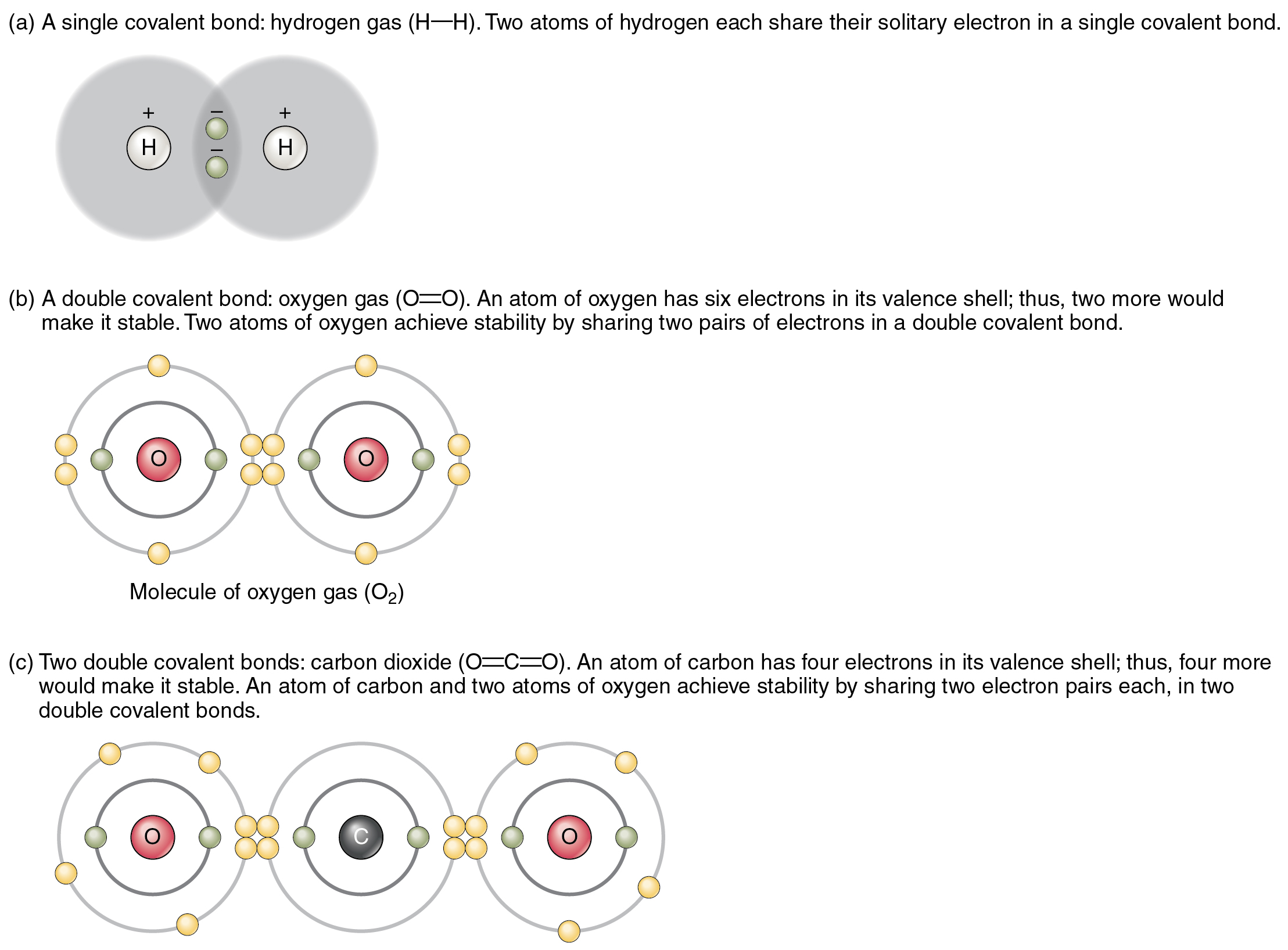
You’ll be able to see that the covalent bonds proven in Determine 2.2.2 are balanced. The sharing of the unfavorable electrons is comparatively equal, as is {the electrical} pull of the constructive protons within the nucleus of the atoms concerned. This is the reason covalently bonded molecules which are electrically balanced on this approach are described as nonpolar; that’s, no area of the molecule is both extra constructive or extra unfavorable than every other.
Polar Covalent Bonds
Teams of legislators with fully reverse views on a specific challenge are sometimes described as “polarized” by information writers. In chemistry, a polar molecule is a molecule that incorporates areas which have reverse electrical prices. Polar molecules happen when atoms share electrons unequally, in polar covalent bonds.
Essentially the most acquainted instance of a polar molecule is water (Determine 2.2.3). The molecule has three elements: one atom of oxygen, the nucleus of which incorporates eight protons, and two hydrogen atoms, whose nuclei every include just one proton. Since each proton exerts an equivalent constructive cost, a nucleus that incorporates eight protons exerts a cost eight instances better than a nucleus that incorporates one proton. Because of this the negatively charged electrons current within the water molecule are extra strongly interested in the oxygen nucleus than to the hydrogen nuclei. Every hydrogen atom’s single unfavorable electron, due to this fact, migrates towards the oxygen atom, making the oxygen finish of their bond barely extra unfavorable than the hydrogen finish of their bond.
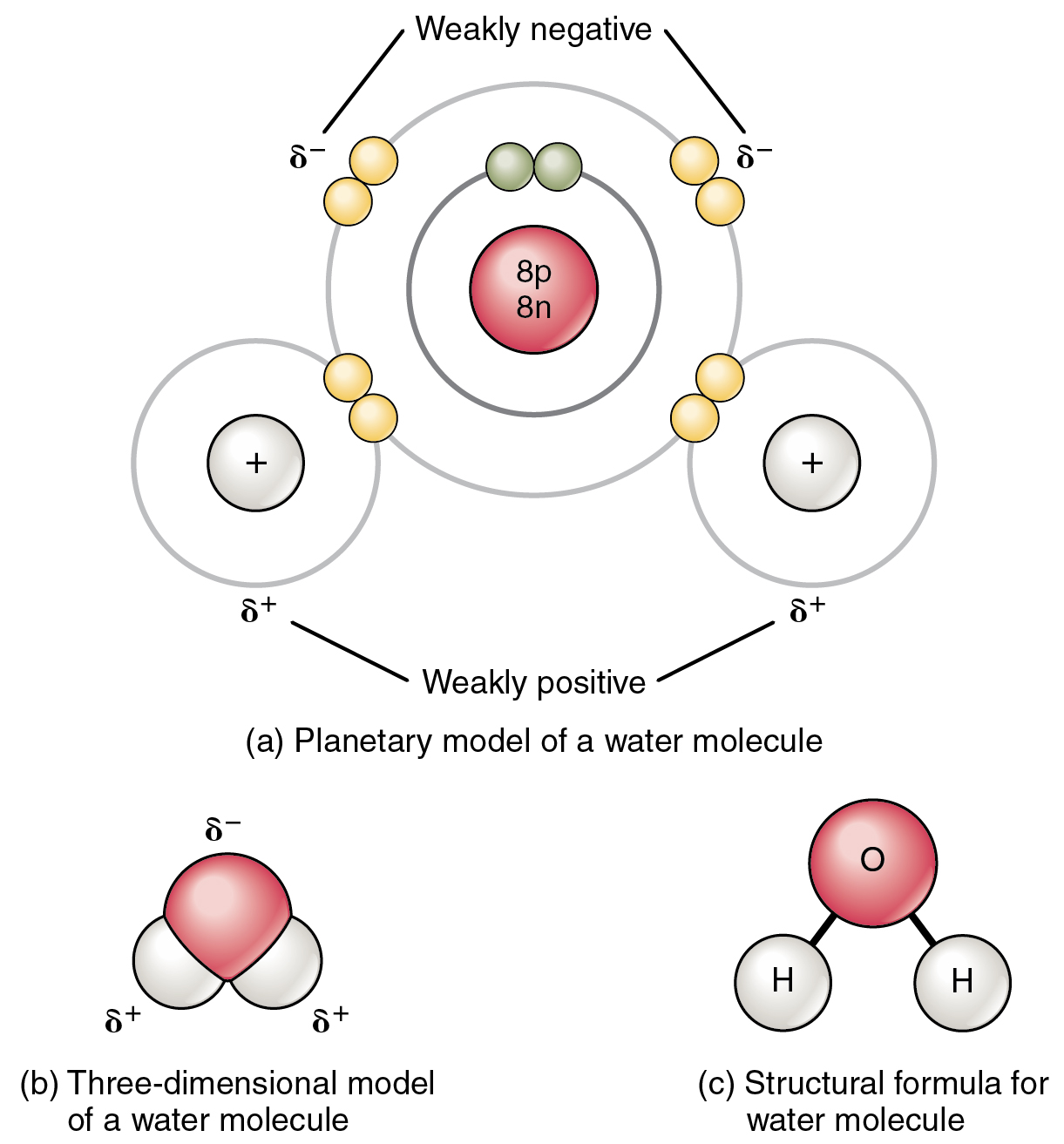
What’s true for the bonds is true for the water molecule as a complete; that’s, the oxygen area has a barely unfavorable cost and the areas of the hydrogen atoms have a barely constructive cost. These prices are sometimes called “partial prices” as a result of the power of the cost is lower than one full electron, as would happen in an ionic bond. As proven in Determine 2.2.3, areas of weak polarity are indicated with the Greek letter delta (∂) and a plus (+) or minus (–) signal.
Regardless that a single water molecule is unimaginably tiny, it has mass, and the opposing electrical prices on the molecule pull that mass in such a approach that it creates a form considerably like a triangular tent (see Determine 2.2.3b). This dipole, with the constructive prices at one finish fashioned by the hydrogen atoms on the “backside” of the tent and the unfavorable cost on the reverse finish (the oxygen atom on the “high” of the tent) makes the charged areas extremely prone to work together with charged areas of different polar molecules. For human physiology, the ensuing bond, fashioned by water, is among the most necessary—the hydrogen bond.
Hydrogen Bonds
A hydrogen bond is fashioned when a weakly constructive hydrogen atom already bonded to 1 electronegative atom (for instance, the oxygen within the water molecule) is attracted to a different electronegative atom from one other molecule. In different phrases, hydrogen bonds at all times embrace hydrogen that’s already a part of a polar molecule.
The commonest instance of hydrogen bonding within the pure world happens between molecules of water. It occurs earlier than your eyes each time two raindrops merge into a bigger bead, or a creek spills right into a river. Hydrogen bonding happens as a result of the weakly unfavorable oxygen atom in a single water molecule is interested in the weakly constructive hydrogen atoms of two different water molecules (Determine 2.2.4).
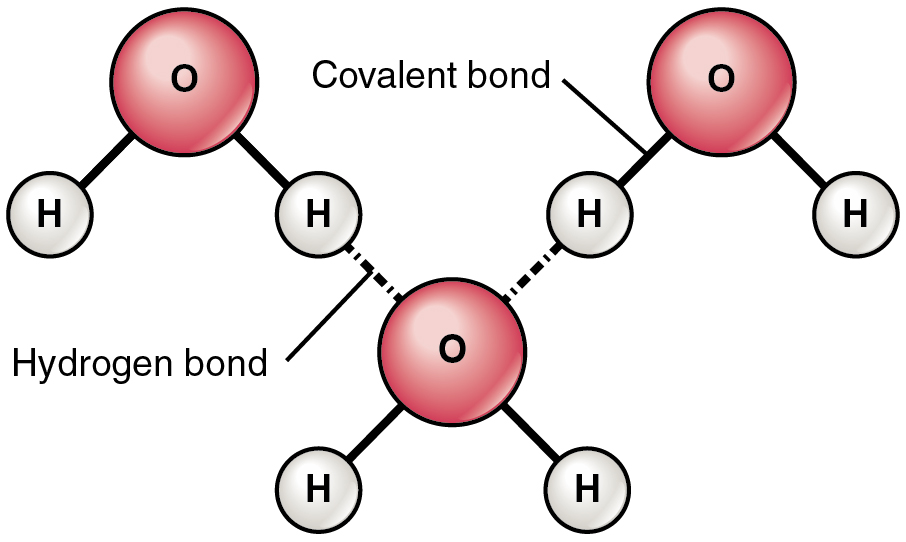
Discover that the bonds happen between the weakly constructive cost on the hydrogen atoms and the weakly unfavorable cost on the oxygen atoms. Hydrogen bonds are comparatively weak, and due to this fact are indicated with a dotted (moderately than a stable) line.
Water molecules additionally strongly appeal to different varieties of charged molecules in addition to ions. This explains why “desk salt,” for instance, truly is a molecule referred to as a “salt” in chemistry; it consists of equal numbers of positively-charged sodium (Na+) and negatively-charged chloride (Cl–), dissolves so readily in water, on this case, forming dipole-ion bonds between the water and the electrically-charged ions (electrolytes). Water molecules additionally repel molecules with nonpolar covalent bonds, like fat, lipids, and oils. You’ll be able to display this with a easy kitchen experiment: pour a teaspoon of vegetable oil, a compound fashioned by nonpolar covalent bonds, right into a glass of water. As an alternative of immediately dissolving within the water, the oil kinds a definite bead as a result of the polar water molecules repel the nonpolar oil.
Chapter Overview
Every second of life, atoms of oxygen, carbon, hydrogen, and the opposite components of the human physique are making and breaking chemical bonds. Ions are charged atoms that kind when an atom donates or accepts a number of negatively charged electrons. Cations (ions with a constructive cost) are interested in anions (ions with a unfavorable cost). This attraction is named an ionic bond. In covalent bonds, the collaborating atoms don’t lose or acquire electrons, however share them. Molecules with nonpolar covalent bonds are electrically balanced, and have a linear three-dimensional form. Molecules with polar covalent bonds have “poles”—areas of weakly constructive and unfavorable cost—and have a triangular three-dimensional form. An atom of oxygen and two atoms of hydrogen kind water molecules by way of polar covalent bonds. Hydrogen bonds hyperlink hydrogen atoms already collaborating in polar covalent bonds to anions or electronegative areas of different polar molecules. Hydrogen bonds hyperlink water molecules, ensuing within the properties of water which are necessary to dwelling issues.
2.3 Chemical Reactions
Studying Goals
By the top of this part, it is possible for you to to:
- Distinguish between kinetic and potential power, and between exergonic and endergonic chemical reactions
- Determine 4 types of power necessary in human functioning
- Describe the three primary varieties of chemical reactions
- Determine a number of components influencing the speed of chemical reactions
One attribute of a dwelling organism is metabolism, which is the sum complete of all the chemical reactions that go on to keep up that organism’s well being and life. The bonding processes you could have realized up to now are anabolic chemical reactions; they kind bigger molecules from smaller molecules or atoms. Recall that metabolism can proceed in one other route: in catabolic chemical reactions, when bonds between parts of bigger molecules break, releasing smaller molecules or atoms. Each varieties of reactions contain exchanges not solely of matter, however of power.
The Position of Vitality in Chemical Reactions
Chemical reactions require a adequate quantity of power to trigger the matter to collide with sufficient precision and drive that previous chemical bonds could be damaged and new ones fashioned. Basically, kinetic power is the type of power powering any sort of matter in movement. Think about you might be constructing a brick wall. The power it takes to carry and place one brick atop one other is kinetic power—the power matter possesses due to its movement. As soon as the wall is in place, it shops potential power. Potential power is the power of place, or the power matter possesses due to the positioning or construction of its parts. If the brick wall collapses, the saved potential power is launched as kinetic power when the bricks fall.
Within the human physique, potential power is saved within the bonds between atoms and molecules. Chemical power is the type of potential power during which power is saved in chemical bonds. When these bonds are fashioned, chemical power is invested, and once they break, chemical power is launched. Discover that chemical power, like all power, is neither created nor destroyed, moderately, it’s transformed from one kind to a different. While you eat an power bar earlier than heading out the door for a hike, the honey, nuts, and different meals the bar incorporates are damaged down and rearranged by your physique into molecules that your muscle cells convert to kinetic power.
Chemical reactions that launch extra power than they take up are characterised as exergonic. The catabolism of the meals in your power bar is an instance. Among the chemical power saved within the bar is absorbed into molecules your physique makes use of for gas, however a few of it’s launched—for instance, as warmth. In distinction, chemical reactions that take up extra power than they launch are endergonic. These reactions require power enter and the ensuing molecule shops not solely the chemical power within the authentic parts, but in addition the power that fueled the response. Since power is neither created nor destroyed, the place does the power wanted for endergonic reactions come from? In lots of circumstances, it comes from exergonic reactions.
Types of Vitality Necessary in Human Functioning
You’ve got already realized that chemical power is absorbed, saved, and launched by chemical bonds. Along with chemical power, mechanical, radiant, and electrical power are necessary in human functioning.
- Mechanical power, which is saved in bodily techniques akin to machines, engines, or the human physique, straight powers the motion of matter. While you carry a brick into place on a wall, your muscle groups present the mechanical power that strikes the brick.
- Radiant power is power emitted and transmitted as waves moderately than matter. These waves fluctuate in size from lengthy radio waves and microwaves to quick gamma waves emitted from decaying atomic nuclei. The total spectrum of radiant power is known as the electromagnetic spectrum. The physique makes use of the ultraviolet power of daylight to transform a compound in pores and skin cells to vitamin D, which is important to human functioning. The human eye advanced to see the wavelengths that comprise the colours of the rainbow, from purple to violet, in order that vary within the spectrum is named “seen gentle.”
- Electrical power, provided by electrolytes in cells and physique fluids, contributes to the voltage adjustments that assist transmit impulses in nerve and muscle cells.
Traits of Chemical Reactions
All chemical reactions start with a reactant, the overall time period for a number of substances that enter into the response. Sodium and chloride ions, for instance, are the reactants within the manufacturing of desk salt. A number of substances produced by a chemical response are referred to as the product.
In chemical reactions, the parts of the reactants—the weather concerned and the variety of atoms of every—are all current within the product(s). Equally, there’s nothing current within the merchandise that aren’t current within the reactants. It’s because chemical reactions are ruled by the legislation of conservation of mass, which states that matter can’t be created or destroyed in a chemical response.
Simply as you may specific mathematical calculations in equations akin to 2 + 7 = 9, you should use chemical equations to point out how reactants change into merchandise. As in math, chemical equations proceed from left to proper, however as an alternative of an equal signal, they make use of an arrow or arrows indicating the route during which the chemical response proceeds. For instance, the chemical response during which one atom of nitrogen and three atoms of hydrogen produce ammonia can be written as N + 3H→ NH3. Correspondingly, the breakdown of ammonia into its parts can be written as NH3 →N + 3H.
Discover that, within the first instance, a nitrogen (N) atom and three hydrogen (H) atoms bond to kind a compound. This anabolic response requires power, which is then saved inside the compound’s bonds. Such reactions are known as synthesis reactions. A synthesis response is a chemical response that ends in the synthesis (becoming a member of) of parts that have been previously separate (Determine 2.3.1a). Once more, nitrogen and hydrogen are reactants in a synthesis response that yields ammonia because the product. The overall equation for a synthesis response is A + B→AB.
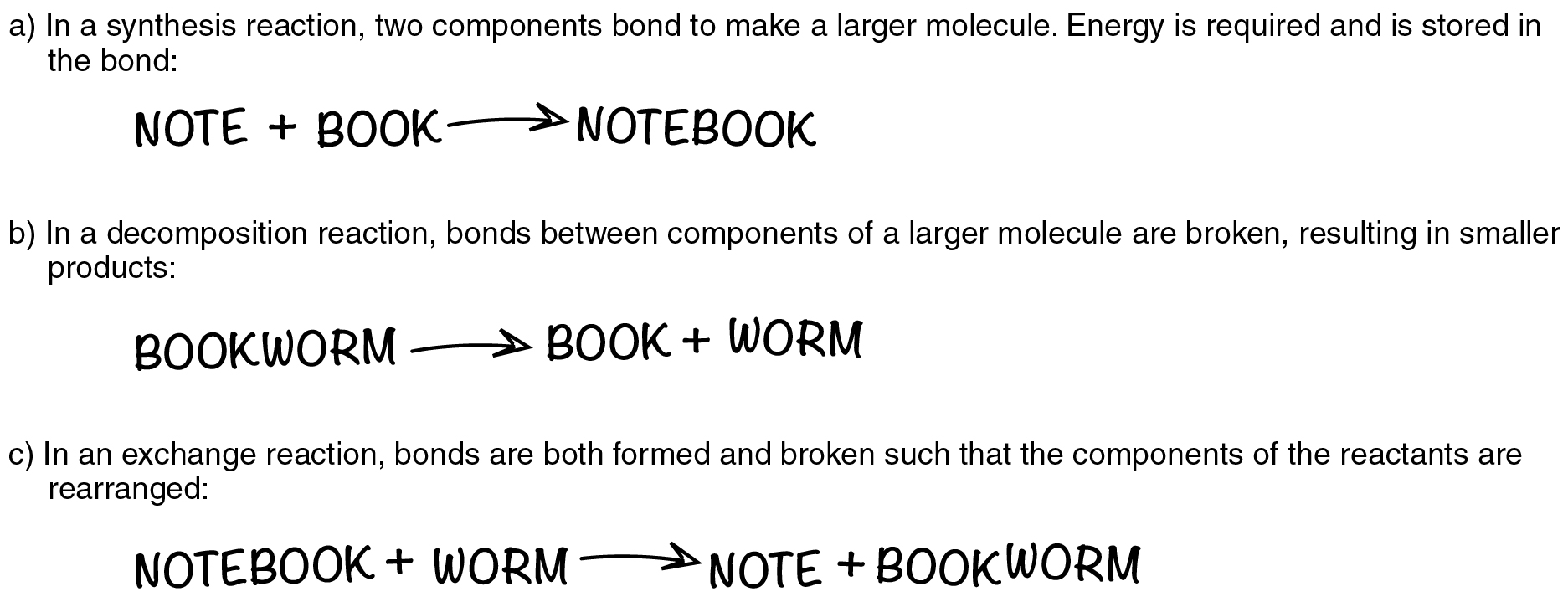
Within the second instance, ammonia is catabolized into its smaller parts, and the potential power that had been saved in its bonds is launched. Such reactions are known as decomposition reactions. A decomposition response is a chemical response that breaks down or “de-composes” one thing bigger into its constituent elements (see Determine 2.3.1b). The overall equation for a decomposition response is: AB→A+B.
An alternate response is a chemical response during which each synthesis and decomposition happen, chemical bonds are each fashioned and damaged, and chemical power is absorbed, saved, and launched (see Determine 2.3.1c). The best type of an alternate response could be: A+BC→AB+C. Discover that, to supply these merchandise, B and C needed to break aside in a decomposition response, whereas A and B needed to bond in a synthesis response. A extra complicated alternate response could be: AB+CD→AC+B. One other instance could be: AB+CD→AD+BC.
In idea, any chemical response can proceed in both route beneath the fitting situations. Reactants might synthesize right into a product that’s later decomposed. Reversibility can also be a top quality of alternate reactions. As an illustration, A+BC→AB+C may then reverse to AB+C→A+BC. This reversibility of a chemical response is indicated with a double arrow: A+BC⇄AB+C. Nonetheless, within the human physique, many chemical reactions do proceed in a predictable route, both in some way. You’ll be able to consider this extra predictable path as the trail of least resistance as a result of, sometimes, the alternate route requires extra power.
Elements Influencing the Price of Chemical Reactions
Should you pour vinegar into baking soda, the response is instantaneous; the concoction will bubble and champagne, however many chemical reactions take time. Quite a lot of components affect the speed of chemical reactions. This part, nevertheless, will take into account solely an important in human functioning.
Properties of the Reactants
If chemical reactions are to happen rapidly, the atoms within the reactants should have easy accessibility to 1 one other. Thus, the better the floor space of the reactants, the extra readily they may work together. While you pop a dice of cheese into your mouth, you chew it earlier than you swallow it. Amongst different issues, chewing will increase the floor space of the meals in order that digestive chemical compounds can extra simply get at it. As a common rule, gases are inclined to react quicker than liquids or solids, once more as a result of it takes power to separate particles of a substance, and gases by definition have already got house between their particles. Equally, the bigger the molecule, the better the variety of complete bonds, so reactions involving smaller molecules, with fewer complete bonds, can be anticipated to proceed quicker.
As well as, recall that some components are extra reactive than others. Reactions that contain extremely reactive components like hydrogen proceed extra rapidly than reactions that contain much less reactive components. Reactions involving secure components like helium should not prone to occur in any respect.
Temperature
Practically all chemical reactions happen at a quicker fee at greater temperatures. Recall that kinetic power is the power of matter in movement. The kinetic power of subatomic particles will increase in response to will increase in thermal power. The upper the temperature, the quicker the particles transfer, and the extra probably they’re to return involved and react.
Focus and Stress
If just some persons are dancing at a membership, they’re unlikely to step on one another’s toes. As increasingly more folks stand up to bounce—particularly if the music is quick—collisions are prone to happen. It’s the identical with chemical reactions: the extra particles current inside a given house, the extra probably these particles are to stumble upon each other. Because of this chemists can velocity up chemical reactions not solely by rising the focus of particles—the variety of particles within the house—but in addition by lowering the quantity of the house, which might correspondingly enhance the strain. If there have been 100 dancers in that membership, and the supervisor abruptly moved the get together to a room half the dimensions, the focus of the dancers would double within the new house, and the chance of collisions would enhance accordingly.
Enzymes and Different Catalysts
For 2 chemical compounds in nature to react with one another they first have to return into contact, and this happens by way of random collisions. Since warmth helps enhance the kinetic power of atoms, ions, and molecules, it promotes their collision. Nonetheless, within the physique, extraordinarily excessive warmth—akin to a really excessive fever—can injury physique cells and be life-threatening. Then again, regular physique temperature will not be excessive sufficient to advertise the chemical reactions that maintain life. That’s the place catalysts are available.
In chemistry, a catalyst is a substance that will increase the speed of a chemical response with out itself present process any change. You’ll be able to consider a catalyst as a chemical change agent. They assist enhance the speed and drive at which atoms, ions, and molecules collide, thereby rising the chance that their valence shell electrons will work together.
Crucial catalysts within the human physique are enzymes. An enzyme is a catalyst composed of protein or ribonucleic acid (RNA), each of which might be mentioned later on this chapter. Like all catalysts, enzymes work by reducing the extent of power that must be invested in a chemical response. A chemical response’s activation power is the “threshold” stage of power wanted to interrupt the bonds within the reactants. As soon as these bonds are damaged, new preparations can kind. With out an enzyme to behave as a catalyst, a a lot bigger funding of power is required to ignite a chemical response (Determine 2.3.2).
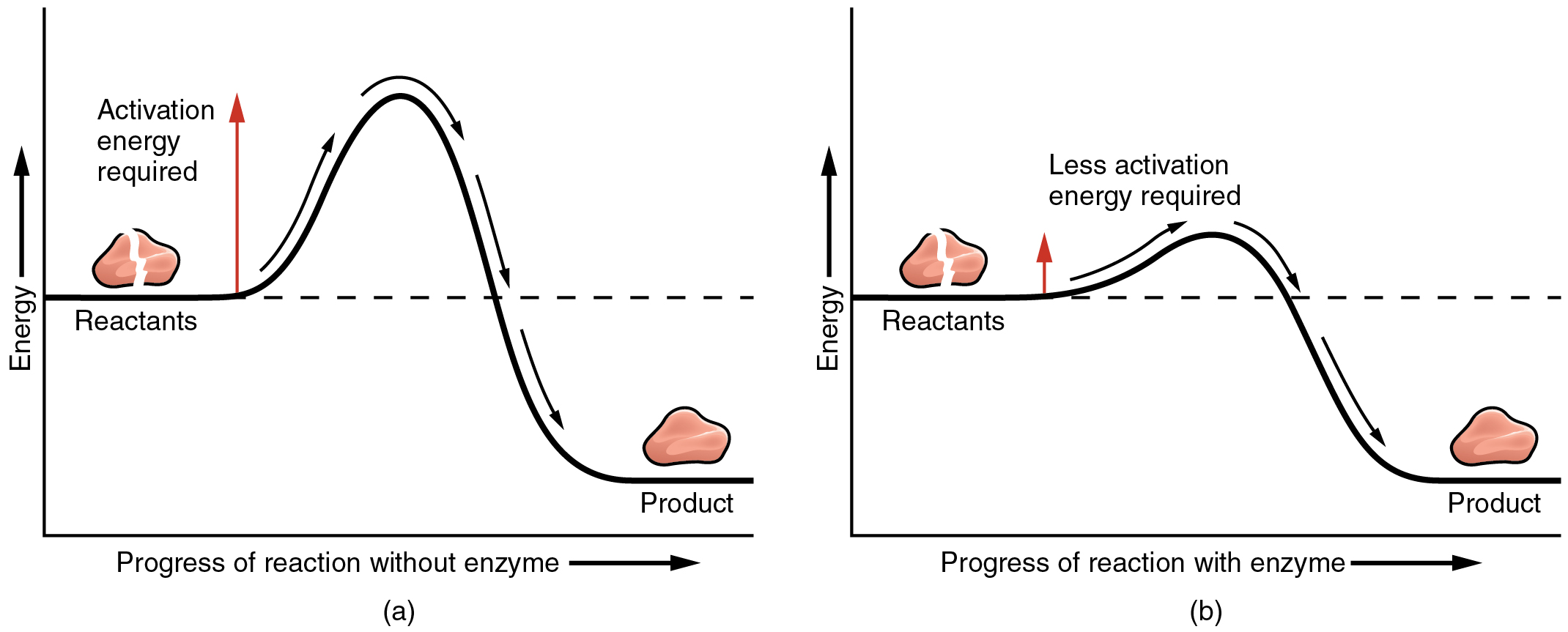
Enzymes are essential to the physique’s wholesome functioning. They help, for instance, with the breakdown of meals and its conversion to power. In reality, a lot of the chemical reactions within the physique are facilitated by enzymes.
Chapter Overview
Chemical reactions, during which chemical bonds are damaged and fashioned, require an preliminary funding of power. Kinetic power, the power of matter in movement, fuels the collisions of atoms, ions, and molecules which are essential if their previous bonds are to interrupt and new ones to kind. All molecules retailer potential power, which is launched when their bonds are damaged.
4 types of power important to human functioning are: chemical power (which is saved and launched as chemical bonds are fashioned and damaged), mechanical power (which straight powers bodily exercise), radiant power (emitted as waves akin to in daylight), and electrical power, the facility of shifting electrons.
Chemical reactions start with reactants and finish with merchandise. Synthesis reactions bond reactants collectively, a course of that requires power, whereas decomposition reactions break the bonds inside a reactant and thereby launch power. In alternate reactions, bonds are each damaged and fashioned, and power is exchanged.
The speed at which chemical reactions happen is influenced by a number of properties of the reactants: temperature, focus and strain, and the presence or absence of a catalyst. An enzyme is a catalytic protein that quickens chemical reactions within the human physique.
2.4 Inorganic Compounds Important to Human Functioning
Studying Goals
By the top of this part, it is possible for you to to:
- Evaluate and distinction inorganic and natural compounds
- Determine the properties of water that make it important to life
- Clarify the position of salts in physique functioning
- Distinguish between acids and bases, and clarify their position in pH
- Talk about the position of buffers in serving to the physique keep pH homeostasis
The ideas you could have realized up to now on this chapter govern all types of matter, and would work as a basis for geology in addition to biology. This part of the chapter narrows the main focus to the chemistry of human life; that’s, the compounds necessary for the physique’s construction and performance. Basically, these compounds are both inorganic or natural.
- An inorganic compound is a substance that doesn’t include each carbon and hydrogen. A terrific many inorganic compounds do include hydrogen atoms, akin to water (H2O) and the hydrochloric acid (HCl) produced by your abdomen. In distinction, solely a handful of inorganic compounds include carbon atoms. Carbon dioxide (CO2) is among the few examples.
- An natural compound is a substance that incorporates each carbon and hydrogen. Natural compounds are synthesized through covalent bonds inside dwelling organisms, together with the human physique. Recall that carbon and hydrogen are the second and third most plentiful components in your physique. You’ll quickly uncover how these two components mix within the meals you eat, within the compounds that make up your physique construction, and within the chemical compounds that gas your functioning.
The next part examines the 4 teams of inorganic compounds important to life: water, salts, acids, and bases. Natural compounds are lined later within the chapter.
Water
As a lot as 70 % of an grownup’s physique weight is water. This water is contained each inside the cells and between the cells that make up tissues and organs. Its a number of roles make water indispensable to human functioning.
Water as a Lubricant and Cushion
Water is a significant element of lots of the physique’s lubricating fluids. Simply as oil lubricates the hinge on a door, water in synovial fluid lubricates the actions of physique joints, and water in pleural fluid helps the lungs develop and recoil with respiratory. Watery fluids assist preserve meals flowing by way of the digestive tract, and make sure that the motion of adjoining stomach organs is friction free.
Water additionally protects cells and organs from bodily trauma, cushioning the mind inside the cranium, for instance, and defending the fragile nerve tissue of the eyes. Water cushions a creating fetus within the mom’s womb as nicely.
Water as a Warmth Sink
A warmth sink is a substance or object that absorbs and dissipates warmth however doesn’t expertise a corresponding enhance in temperature. Within the physique, water absorbs the warmth generated by chemical reactions with out tremendously rising in temperature. Furthermore, when the environmental temperature soars, the water saved within the physique helps preserve the physique cool. This cooling impact occurs as heat blood from the physique’s core flows to the blood vessels slightly below the pores and skin and is transferred to the atmosphere. On the identical time, sweat glands launch heat water in sweat. Because the water evaporates into the air, it carries away warmth, after which the cooler blood from the periphery circulates again to the physique core.
Water as a Part of Liquid Mixtures
A mix is a mixture of two or extra substances, every of which maintains its personal chemical id. In different phrases, the constituent substances should not chemically bonded into a brand new, bigger chemical compound. The idea is straightforward to think about in case you consider powdery substances akin to flour and sugar; whenever you stir them collectively in a bowl, they clearly don’t bond to kind a brand new compound. The room air you breathe is a gaseous combination, containing three discrete components—nitrogen, oxygen, and argon—and one compound, carbon dioxide. There are three varieties of liquid mixtures, all of which include water as a key element; these are options, colloids, and suspensions.
For cells within the physique to outlive, they should be saved moist in a water-based liquid referred to as an answer. In chemistry, a liquid resolution consists of a solvent that dissolves a substance referred to as a solute. An necessary attribute of options is that they’re homogeneous; that’s, the solute molecules are distributed evenly all through the answer. Should you have been to stir a teaspoon of sugar right into a glass of water, the sugar would dissolve into sugar molecules separated by water molecules. The ratio of sugar to water within the left aspect of the glass can be the identical because the ratio of sugar to water in the fitting aspect of the glass. Should you have been so as to add extra sugar, the ratio of sugar to water would change, however the distribution—supplied you had stirred nicely—would nonetheless be even.
Water is taken into account the “common solvent” and it’s believed that life can’t exist with out water due to this. Water is actually probably the most plentiful solvent within the physique; basically all the physique’s chemical reactions happen amongst compounds dissolved in water. Since water molecules are polar, with areas of constructive and unfavorable electrical cost, water readily dissolves ionic compounds and polar covalent compounds. Such compounds are known as hydrophilic, or “water-loving.” As talked about above, sugar dissolves nicely in water. It’s because sugar molecules include areas of hydrogen-oxygen polar bonds, making it hydrophilic. Nonpolar molecules, which don’t readily dissolve in water, are referred to as hydrophobic, or “water-fearing.”
Concentrations of Solutes
Numerous mixtures of solutes and water are described in chemistry. The focus of a given solute is the variety of particles of that solute in a given house (oxygen makes up about 21 % of atmospheric air). Within the bloodstream of people, glucose focus is normally measured in milligram (mg) per deciliter (dL), and in a wholesome grownup averages about 100 mg/dL. One other methodology of measuring the focus of a solute is by its molarilty—which is moles (M) of the molecules per liter (L). The mole of a component is its atomic weight, whereas a mole of a compound is the sum of the atomic weights of its parts, referred to as the molecular weight. An often-used instance is calculating a mole of glucose, with the chemical method C6H12O6. Utilizing the periodic desk, the atomic weight of carbon (C) is 12.011 grams (g), and there are six carbons in glucose, for a complete atomic weight of 72.066 g. Doing the identical calculations for hydrogen (H) and oxygen (O), the molecular weight equals 180.156g (the “gram molecular weight” of glucose). When water is added to make one liter of resolution, you could have one mole (1M) of glucose. That is notably helpful in chemistry due to the connection of moles to “Avogadro’s quantity.” A mole of any resolution has the identical variety of particles in it: 6.02 × 1023. Many substances within the bloodstream and different tissue of the physique are measured in thousandths of a mole, or millimoles (mM).
A colloid is a combination that’s considerably like a heavy resolution. The solute particles include tiny clumps of molecules massive sufficient to make the liquid combination opaque (as a result of the particles are massive sufficient to scatter gentle). Acquainted examples of colloids are milk and cream. Within the thyroid glands, the thyroid hormone is saved as a thick protein combination additionally referred to as a colloid.
A suspension is a liquid combination during which a heavier substance is suspended briefly in a liquid, however over time, settles out. This separation of particles from a suspension is named sedimentation. An instance of sedimentation happens within the blood take a look at that establishes sedimentation fee, or sed fee. The take a look at measures how rapidly purple blood cells in a take a look at tube settle out of the watery portion of blood (often called plasma) over a set time frame. Speedy sedimentation of blood cells doesn’t usually occur within the wholesome physique, however elements of sure illnesses could cause blood cells to clump collectively, and these heavy clumps of blood cells settle to the underside of the take a look at tube extra rapidly than do regular blood cells.
The Position of Water in Chemical Reactions
Two varieties of chemical reactions contain the creation or the consumption of water: dehydration synthesis and hydrolysis.
- In dehydration synthesis, one reactant provides up an atom of hydrogen and one other reactant provides up a hydroxyl group (OH) within the synthesis of a brand new product. Within the formation of their covalent bond, a molecule of water is launched as a byproduct (Determine 2.4.1). That is additionally typically known as a condensation response.
- In hydrolysis, a molecule of water disrupts a compound, breaking its bonds. The water is itself break up into H and OH. One portion of the severed compound then bonds with the hydrogen atom, and the opposite portion bonds with the hydroxyl group.
These reactions are reversible, and play an necessary position within the chemistry of natural compounds (which might be mentioned shortly).
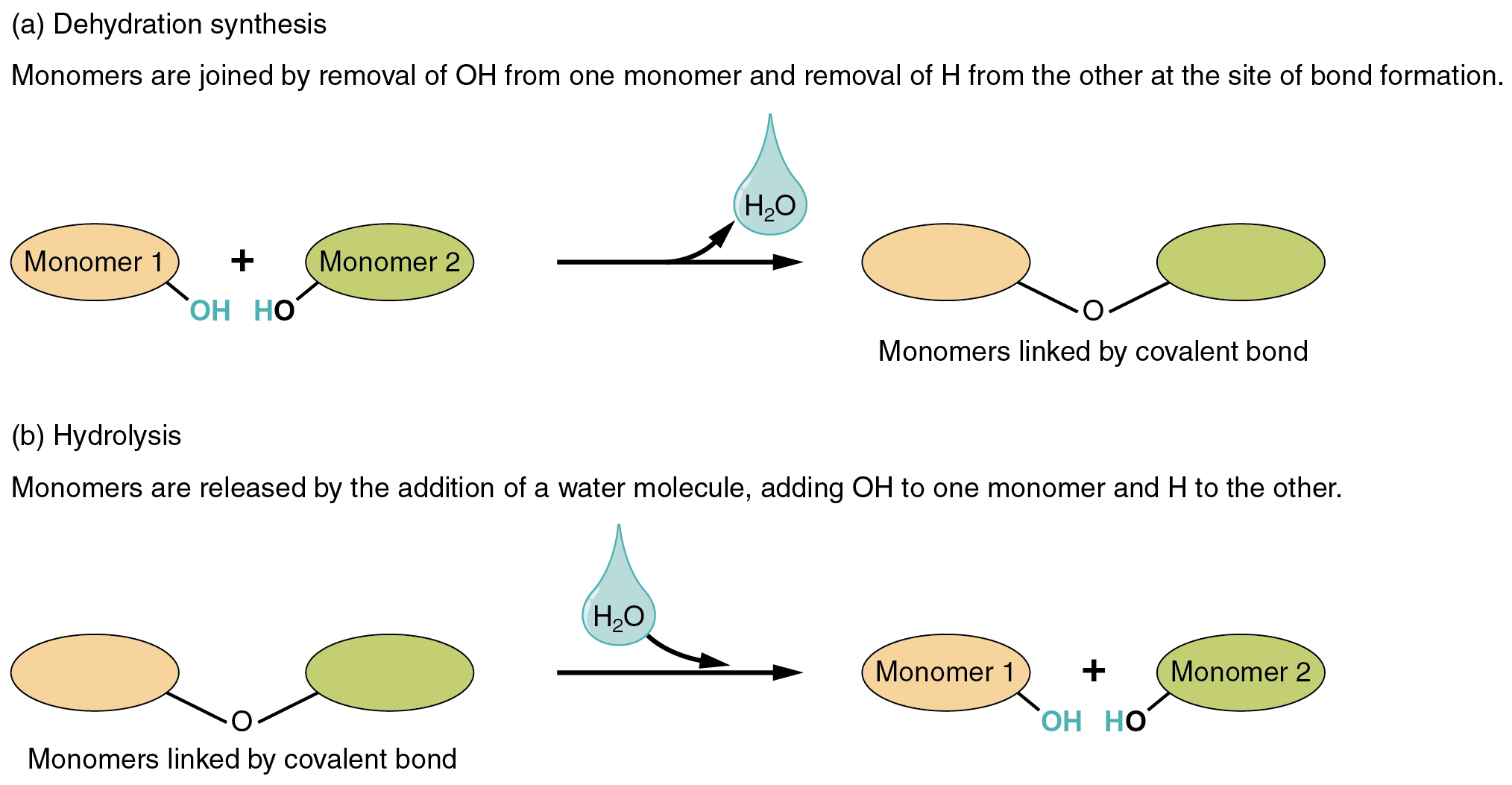
Salts
Recall that salts are fashioned when ions kind ionic bonds. In these reactions, one atom provides up a number of electrons, and thus turns into positively charged, whereas the opposite accepts a number of electrons and turns into negatively charged. Now you can outline a salt as a substance that, when dissolved in water, dissociates into ions apart from H+ or OH–. This truth is necessary in distinguishing salts from acids and bases, mentioned subsequent.
A typical salt, NaCl, dissociates fully in water (Determine 2.4.2). The constructive and unfavorable areas on the water molecule (the hydrogen and oxygen ends respectively) appeal to the unfavorable chloride and constructive sodium ions, pulling them away from one another. Once more, whereas nonpolar and polar covalently bonded compounds break aside into molecules in resolution, salts dissociate into ions. These ions are electrolytes; they’re able to conducting {an electrical} present in resolution. This property is essential to the perform of ions in transmitting nerve impulses and prompting muscle contraction.
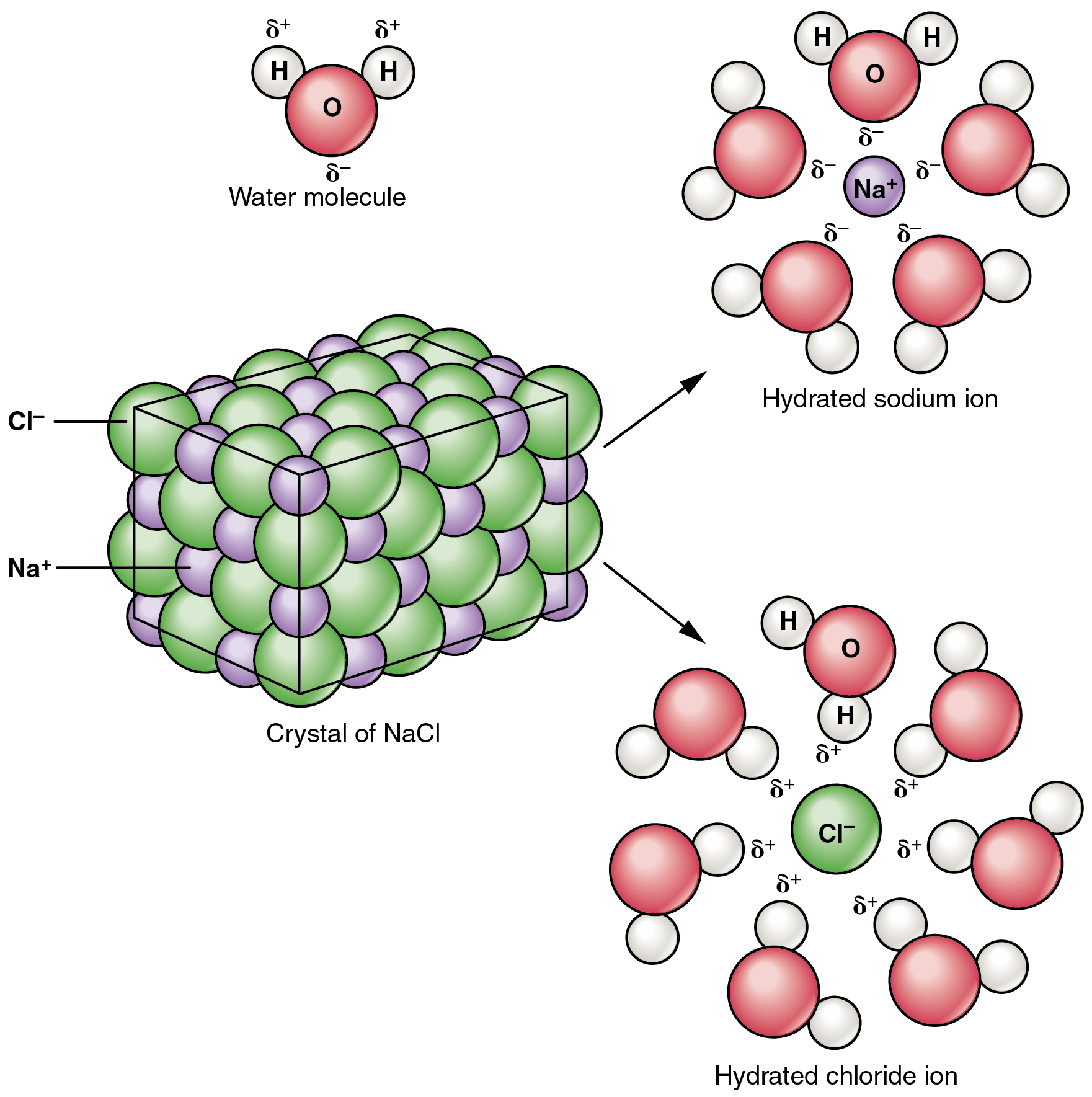
Many different salts are necessary within the physique. For instance, bile salts produced by the liver assist break aside dietary fat, and calcium phosphate salts kind the mineral portion of tooth and bones.
Acids and Bases
Acids and bases, like salts, dissociate in water into electrolytes. Acids and bases can very a lot change the properties of the options during which they’re dissolved.
Acids
An acid is a substance that releases hydrogen ions (H+) in resolution (Determine 2.4.3a). As a result of an atom of hydrogen has only one proton and one electron, a positively charged hydrogen ion is solely a proton. This solitary proton is very prone to take part in chemical reactions. Sturdy acids are compounds that launch all of their H+ in resolution; that’s, they ionize fully. Hydrochloric acid (HCl), which is launched from cells within the lining of the abdomen, is a powerful acid as a result of it releases all of its H+ within the abdomen’s watery atmosphere. This sturdy acid aids in digestion and kills ingested microbes. Weak acids don’t ionize fully; that’s, a few of their hydrogen ions stay bonded inside a compound in resolution. An instance of a weak acid is vinegar, or acetic acid; it’s referred to as acetate after it provides up a proton.
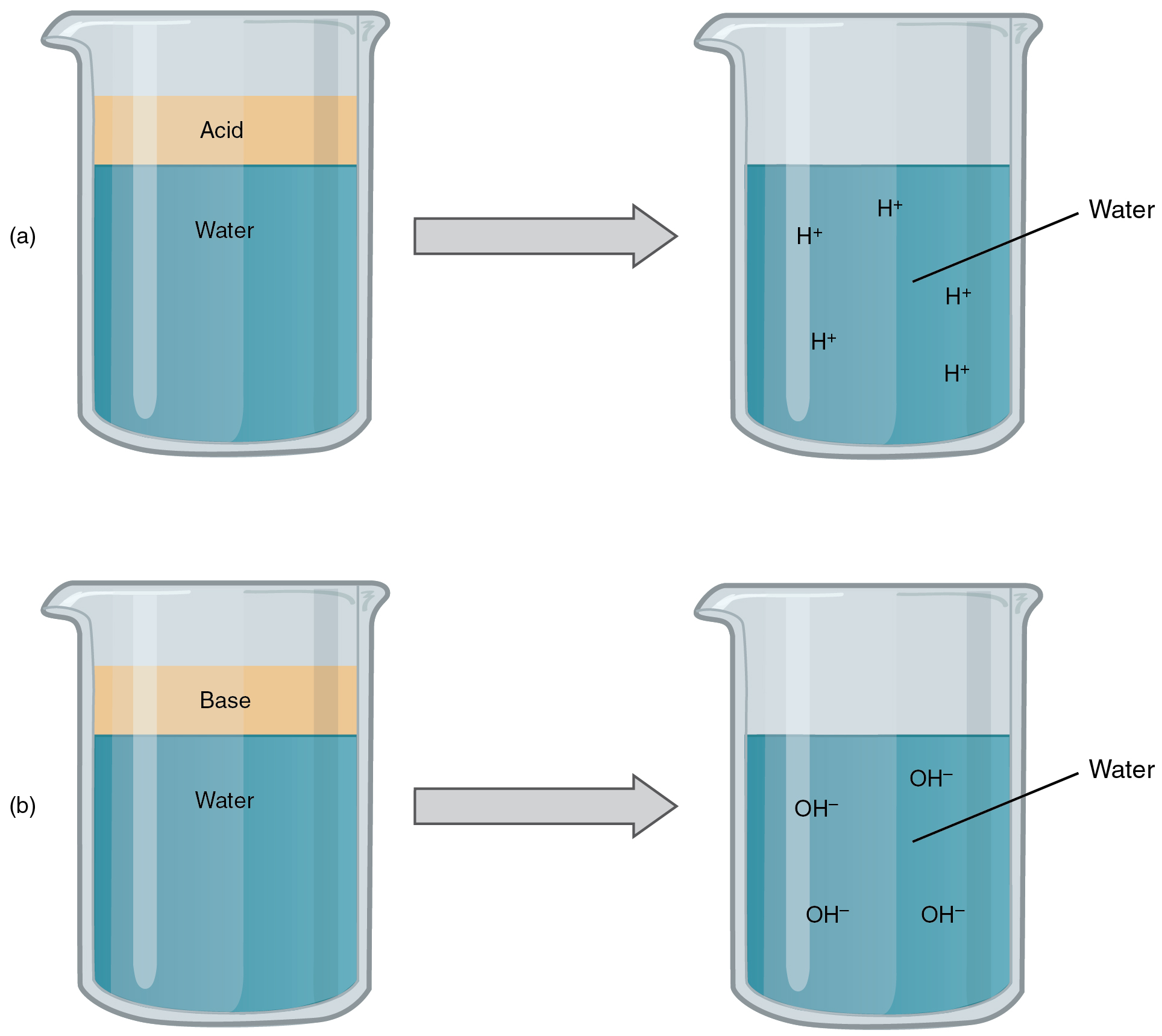
Bases
A base is a substance that releases hydroxyl ions (OH–) in resolution, or one which accepts H+ already current in resolution (see Determine 2.4.3b). The hydroxyl ions (also called hydroxide ions) or different primary substances mix with H+ current to kind a water molecule, thereby eradicating H+ and lowering the answer’s acidity. Sturdy bases launch most or all of their hydroxyl ions; weak bases launch just some hydroxyl ions or take up just a few H+. Meals blended with hydrochloric acid from the abdomen would burn the small gut (the subsequent portion of the digestive tract after the abdomen), if it weren’t for the discharge of bicarbonate (HCO3–), a weak base that draws H+. Bicarbonate accepts among the H+ protons, thereby lowering the acidity of the answer.
The Idea of pH
The relative acidity or alkalinity of an answer could be indicated by its pH. An answer’s pH is the unfavorable, base-10 logarithm of the hydrogen ion (H+) focus of the answer. For instance, a pH 4 resolution has an H+ focus that’s ten instances better than that of a pH 5 resolution. That’s, an answer with a pH of 4 is ten instances extra acidic than an answer with a pH of 5. The idea of pH will start to make extra sense whenever you research the pH scale, as proven in Determine 2.4.4. The dimensions consists of a sequence of increments starting from 0 to 14. An answer with a pH of seven is taken into account impartial—neither acidic nor primary. Pure water has a pH of seven. The decrease the quantity beneath 7, the extra acidic the answer, or the better the focus of H+. The focus of hydrogen ions at every pH worth is 10 instances totally different than the subsequent pH. As an illustration, a pH worth of 4 corresponds to a proton focus of 10–4 M, or 0.0001M, whereas a pH worth of 5 corresponds to a proton focus of 10–5 M, or 0.00001M. The upper the quantity above 7, the extra primary (alkaline) the answer, or the decrease the focus of H+. Human urine, for instance, is ten instances extra acidic than pure water, and HCl is 10,000,000 instances extra acidic than water.
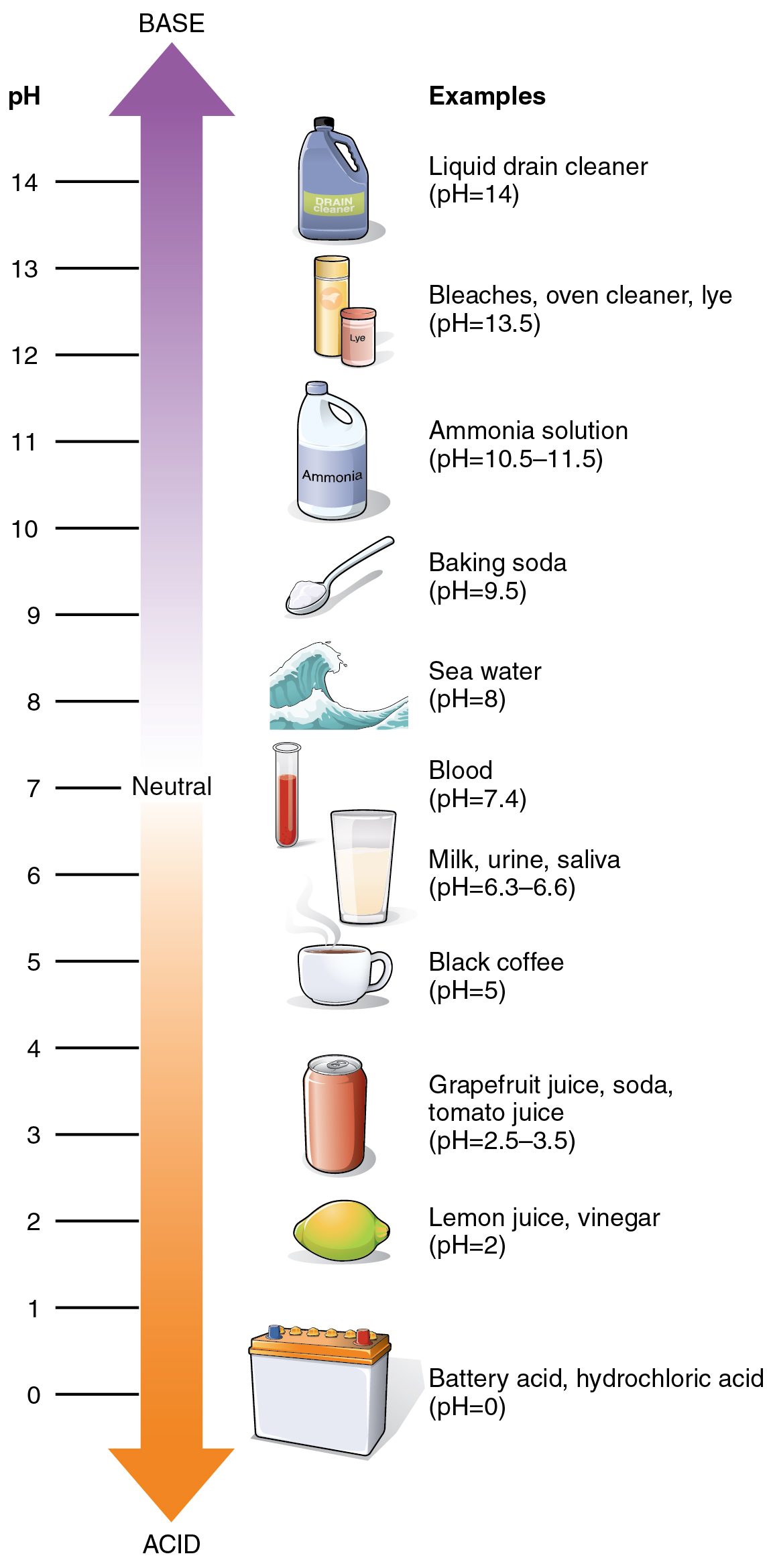
Buffers
The pH of human blood usually ranges from 7.35 to 7.45, though it’s sometimes recognized as pH 7.4. At this barely primary pH, blood can cut back the acidity ensuing from the carbon dioxide (CO2) continuously being launched into the bloodstream by the trillions of cells within the physique. Homeostatic mechanisms (together with exhaling CO2 whereas respiratory) usually preserve the pH of blood inside this slim vary. That is essential, as a result of fluctuations—both too acidic or too alkaline—can result in life-threatening problems.
All cells of the physique rely upon homeostatic regulation of acid–base stability at a pH of roughly 7.4. The physique due to this fact has a number of mechanisms for this regulation, involving respiratory, the excretion of chemical compounds in urine, and the interior launch of chemical compounds collectively referred to as buffers into physique fluids. A buffer is an answer of a weak acid and its conjugate base. A buffer can neutralize small quantities of acids or bases in physique fluids. For instance, if there’s even a slight lower beneath 7.35 within the pH of a bodily fluid, the buffer within the fluid—on this case, appearing as a weak base—will bind the surplus hydrogen ions. In distinction, if pH rises above 7.45, the buffer will act as a weak acid and contribute hydrogen ions.
Homeostatic Imbalances
The extreme acidity of acids and bases, of the blood, and different physique fluids is named acidosis. Widespread causes of acidosis are conditions and problems that cut back the effectiveness of respiratory, particularly the particular person’s capacity to exhale absolutely, which causes a buildup of CO2 (and H+) within the bloodstream. Acidosis may also be attributable to metabolic issues that cut back the extent or perform of buffers that act as bases, or that promote the manufacturing of acids. As an illustration, with extreme diarrhea, an excessive amount of bicarbonate could be misplaced from the physique, permitting acids to construct up in physique fluids. In folks with poorly managed diabetes (ineffective regulation of blood sugar), acids referred to as ketones are produced as a type of physique gas. These can construct up within the blood, inflicting a severe situation referred to as diabetic ketoacidosis. Kidney failure, liver failure, coronary heart failure, most cancers, and different problems can also immediate metabolic acidosis.
In distinction, alkalosis is a situation during which the blood and different physique fluids are too alkaline (primary). As with acidosis, respiratory problems are a significant trigger; nevertheless, in respiratory alkalosis, carbon dioxide ranges fall too low. Lung illness, aspirin overdose, shock, and strange anxiousness could cause respiratory alkalosis, which reduces the traditional focus of H+.
Metabolic alkalosis typically outcomes from extended, extreme vomiting, which causes a lack of hydrogen and chloride ions (as parts of HCl). Medicines may immediate alkalosis. These embrace diuretics that trigger the physique to lose potassium ions, in addition to antacids when taken in extreme quantities, as an example by somebody with persistent heartburn or an ulcer.
Chapter Overview
Inorganic compounds important to human functioning embrace water, salts, acids, and bases. These compounds are inorganic; that’s, they don’t include each hydrogen and carbon. Water is a lubricant and cushion, a warmth sink, a element of liquid mixtures, a byproduct of dehydration synthesis reactions, and a reactant in hydrolysis reactions. Salts are compounds that, when dissolved in water, dissociate into ions apart from H+ or OH–. In distinction, acids launch H+ in resolution, making it extra acidic. Bases settle for H+, thereby making the answer extra alkaline (caustic).
The pH of any resolution is its relative focus of H+. An answer with pH 7 is impartial. Options with pH beneath 7 are acids, and options with pH above 7 are bases. A change in a single digit on the pH scale (e.g., from 7 to eight) represents a ten-fold enhance or lower within the focus of H+. In a wholesome grownup, the pH of blood ranges from 7.35 to 7.45. Homeostatic management mechanisms which are necessary for conserving blood in a wholesome pH vary embrace chemical compounds referred to as buffers, weak acids and weak bases launched when the pH of blood or different physique fluids fluctuates in both route outdoors of this regular vary.
2.5 Natural Compounds Important to Human Functioning
Studying Goals
By the top of this part, it is possible for you to to:
- Determine natural molecules important to human functioning
- Clarify the chemistry behind carbon’s affinity for covalently bonding in natural compounds
- Present examples of carbohydrates, and determine the first capabilities of carbohydrates within the physique
- Talk about lipids necessary in human functioning
- Describe the construction of proteins, and talk about their significance to human functioning
- Determine the constructing blocks of nucleic acids, and the roles of DNA, RNA, and ATP in human functioning
Natural compounds sometimes include teams of carbon atoms covalently bonded to hydrogen, normally oxygen, and sometimes different components as nicely. Created by dwelling issues, they’re discovered all through the world, in soils and seas, business merchandise, and each cell of the human physique. The 4 sorts most necessary to human construction and performance are: carbohydrates, lipids, proteins, and nucleotides. Earlier than exploring these compounds, it is advisable to first perceive the chemistry of carbon.
The Chemistry of Carbon
What makes natural compounds ubiquitous is the chemistry of their carbon core. Recall that carbon atoms have 4 electrons of their valence shell, and that the octet rule dictates that atoms are inclined to react in such a approach as to finish their valence shell with eight electrons. Carbon atoms don’t full their valence shells by donating or accepting 4 electrons. As an alternative, they readily share electrons through covalent bonds.
Usually, carbon atoms share with different carbon atoms, typically forming an extended carbon chain known as a carbon skeleton. After they share, nevertheless, they don’t share all their electrons solely with one another. Relatively, carbon atoms are inclined to share electrons with quite a lot of different components, one in all which is at all times hydrogen. Carbon and hydrogen groupings are referred to as hydrocarbons. Should you research the figures of natural compounds within the the rest of this chapter, you will note a number of with chains of hydrocarbons in a single area of the compound.
Many combos are attainable to fill carbon’s 4 “vacancies.” Carbon might share electrons with oxygen or nitrogen or different atoms in a specific area of an natural compound. Furthermore, the atoms to which carbon atoms bond can also be a part of a purposeful group. A purposeful group is a gaggle of atoms linked by sturdy covalent bonds and have a tendency to perform in chemical reactions as a single unit. You’ll be able to consider purposeful teams as tightly knit “cliques” whose members are unlikely to be parted. 5 purposeful teams are necessary in human physiology: the hydroxyl, carboxyl, amino, methyl and phosphate teams (Desk 2.1).
| Purposeful Group | StructuralFormula | Significance |
| Hydroxyl | —O—H | Hydroxyl teams are polar. They’re parts of all 4 varieties of natural compounds mentioned on this chapter. They’re concerned in dehydration synthesis and hydrolysis reactions. |
| Carboxyl | O—C—OH | Carboxyl teams are discovered inside fatty acids, amino acids, and plenty of different acids. |
| Amino | —N—H2 | Amino teams are discovered inside amino acids, the constructing blocks of proteins. |
| Methyl | —C—H3 | Methyl teams are discovered inside amino acids. |
| Phosphate | —P—O42– | Phosphate teams are discovered inside phospholipids and nucleotides. |
Carbon’s affinity for covalent bonding signifies that many distinct and comparatively secure natural molecules readily kind bigger, extra complicated molecules. Any massive molecule is known as macromolecule (macro- = “massive”), and the natural compounds on this part all match this description. Nonetheless, some macromolecules are made up of a number of “copies” of single models referred to as monomer (mono- = “one”; -mer = “half”). Like beads in an extended necklace, these monomers hyperlink by covalent bonds to kind lengthy polymers (poly- = “many”). There are numerous examples of monomers and polymers among the many natural compounds.
Monomers kind polymers by partaking in dehydration synthesis (see Determine 2.4.1). As was famous earlier, this response ends in the discharge of a molecule of water. Every monomer contributes; one provides up a hydrogen atom and the opposite provides up a hydroxyl group. Polymers are break up into monomers by hydrolysis (-lysis = “rupture”). The bonds between their monomers are damaged, through the donation of a molecule of water, which contributes a hydrogen atom to 1 monomer and a hydroxyl group to the opposite.
Carbohydrates
The time period carbohydrate means “hydrated carbon.” Recall that the foundation hydro- signifies water. A carbohydrate is a molecule composed of carbon, hydrogen, and oxygen; in most carbohydrates, hydrogen and oxygen are present in the identical two-to-one relative proportions they’ve in water. In reality, the chemical method for a “generic” molecule of carbohydrate is (CH2O)n.
Carbohydrates are known as saccharides, a phrase which means “sugars.” Three kinds are necessary within the physique: monosaccharides, disaccharides, and polysaccharides. Monosaccharides are the monomers of carbohydrates. Disaccharides (di- = “two”) are made up of two monomers. Polysaccharides are the polymers, and may include lots of to 1000’s of monomers.
Monosaccharides
A monosaccharide is a monomer of carbohydrates. 5 monosaccharides are necessary within the physique. Three of those are the hexose sugars, so referred to as as a result of they every include six atoms of carbon. These are glucose, fructose, and galactose, proven in Determine 2.5.1a. The remaining monosaccharides are the 2 pentose sugars, every of which incorporates 5 atoms of carbon. They’re ribose and deoxyribose, proven in Determine 2.5.1b.

Disaccharides
A disaccharide is a pair of monosaccharides. Disaccharides are fashioned through dehydration synthesis, and the bond linking them is known as a glycosidic bond (glyco- = “sugar”). Three disaccharides (proven in Determine 2.5.2) are necessary to people. These are sucrose, generally known as desk sugar, lactose, or milk sugar, and maltose, or malt sugar. As you may inform from their widespread names, you eat these in your weight loss program, nevertheless, your physique can’t use them straight. As an alternative, within the digestive tract, they’re break up into their element monosaccharides through hydrolysis.
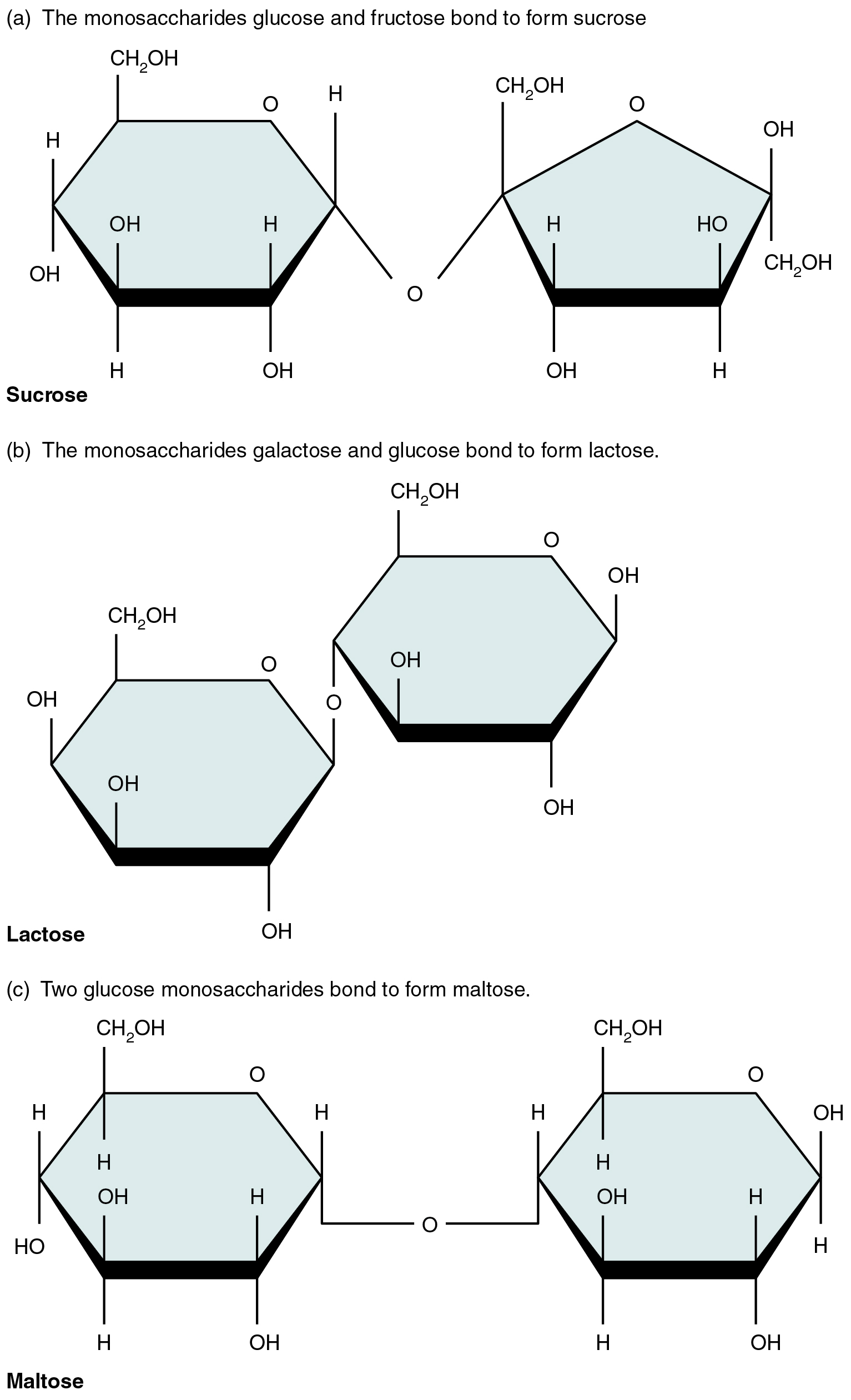
Polysaccharides
Polysaccharides can include just a few to a thousand or extra monosaccharides. Three are necessary to the physique (Determine 2.5.3):
- Starches are polymers of glucose. They happen in lengthy chains referred to as amylose or branched chains referred to as amylopectin, each of that are saved in plant-based meals and are comparatively straightforward to digest.
- Glycogen can also be a polymer of glucose, however it’s saved within the tissues of animals, particularly within the muscle groups and liver. It isn’t thought-about a dietary carbohydrate as a result of little or no glycogen stays in animal tissues after slaughter, nevertheless, the human physique shops extra glucose as glycogen, once more, within the muscle groups and liver.
- Cellulose, a polysaccharide that’s the main element of the cell wall of inexperienced vegetation, is the element of plant meals known as “fiber”. In people, cellulose/fiber will not be digestible, nevertheless, dietary fiber has many well being advantages. It helps you are feeling full so that you eat much less, it promotes a wholesome digestive tract, and a weight loss program excessive in fiber is assumed to cut back the danger of coronary heart illness and probably some types of most cancers.
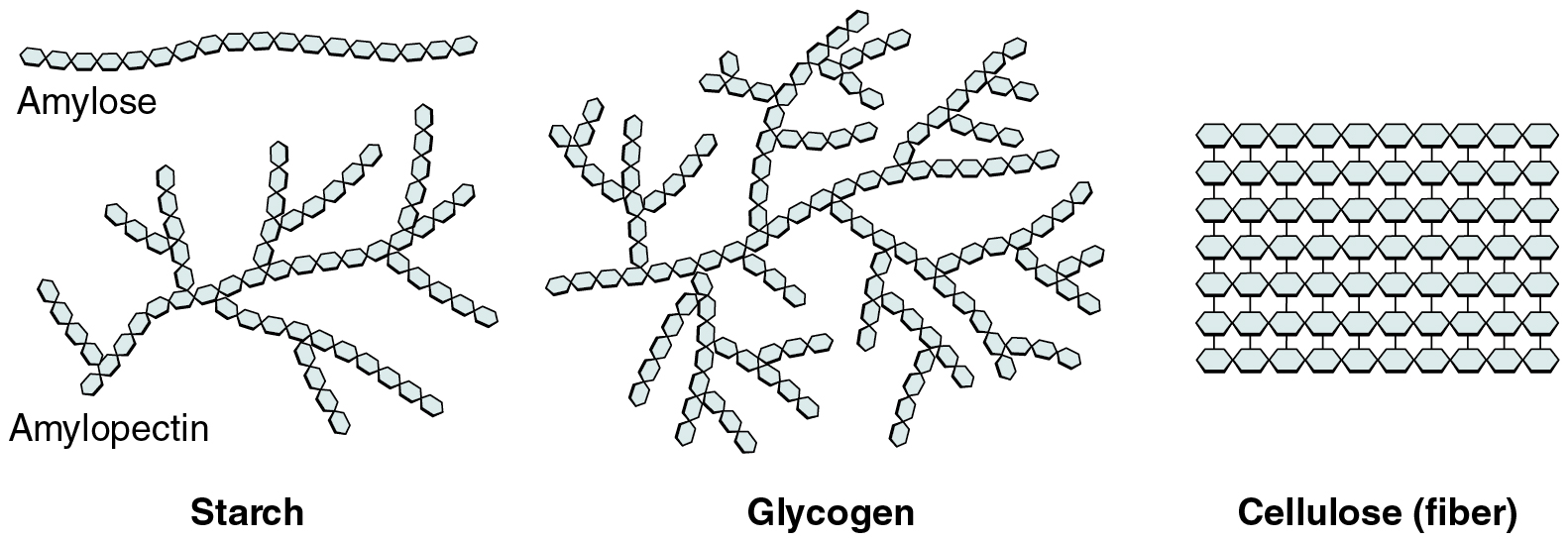
Features of Carbohydrates
The physique obtains carbohydrates from plant-based meals. Grains, fruits, and legumes and different greens present a lot of the carbohydrate within the human weight loss program, though lactose is present in dairy merchandise.
Though most physique cells can break down different natural compounds for gas, all physique cells can use glucose. Furthermore, nerve cells (neurons) within the mind, spinal twine, and thru the peripheral nervous system, in addition to purple blood cells, can solely use glucose for gas. Within the breakdown of glucose for power, molecules of adenosine triphosphate, higher often called ATP, are produced. Adenosine triphosphate (ATP) consists of a ribose sugar, an adenine base, and three phosphate teams. ATP releases free power when its phosphate bonds are damaged, and thus provides prepared power to the cell. Extra ATP is produced within the presence of oxygen (O2) than in pathways that don’t use oxygen. The general response for the conversion of the power in glucose to power saved in ATP could be written:
C6H12O6 + 6 O2 → 6 CO2 + 6 H2O + ATP
Along with being a essential gas supply, carbohydrates are current in very small quantities in cells’ construction. As an illustration, some carbohydrate molecules bind with proteins to supply glycoproteins, and others mix with lipids to supply glycolipids, each of that are discovered within the membrane that encloses the contents of physique cells.
Lipids
A lipid is one in all a extremely various group of compounds made up largely of hydrocarbons. The few oxygen atoms they include are sometimes on the periphery of the molecule. Their nonpolar hydrocarbons make all lipids hydrophobic. In water, lipids don’t kind a real resolution, however they might kind an emulsion, which is the time period for a combination of options that don’t combine nicely.
Triglycerides
A triglyceride is among the most typical dietary lipid teams, and the kind discovered most abundantly in physique tissues. This compound, which is often known as a fats, is fashioned from the synthesis of two varieties of molecules (Determine 2.5.4):
- A glycerol spine on the core of triglycerides, consisting of three carbon atoms.
- Three fatty acids, lengthy chains of hydrocarbons with a carboxyl group and a methyl group at reverse ends, extending from every of the carbons of the glycerol.

Triglycerides kind through dehydration synthesis. Glycerol provides up hydrogen atoms from its hydroxyl teams at every bond, and the carboxyl group on every fatty acid chain provides up a hydroxyl group. A complete of three water molecules are thereby launched.
Fatty acid chains that haven’t any double carbon bonds wherever alongside their size and due to this fact include the utmost variety of hydrogen atoms are referred to as saturated fatty acids. These straight, inflexible chains pack tightly collectively and are stable or semi-solid at room temperature (Determine 2.5.5a). Butter and lard are examples, as is the fats discovered on a steak or in your personal physique. In distinction, fatty acids with one double carbon bond are kinked at that bond (Determine 2.5.5b). These monounsaturated fatty acids are due to this fact unable to pack collectively tightly, and are liquid at room temperature. Polyunsaturated fatty acids include two or extra double carbon bonds, and are additionally liquid at room temperature. Plant oils akin to olive oil sometimes include each mono- and polyunsaturated fatty acids.
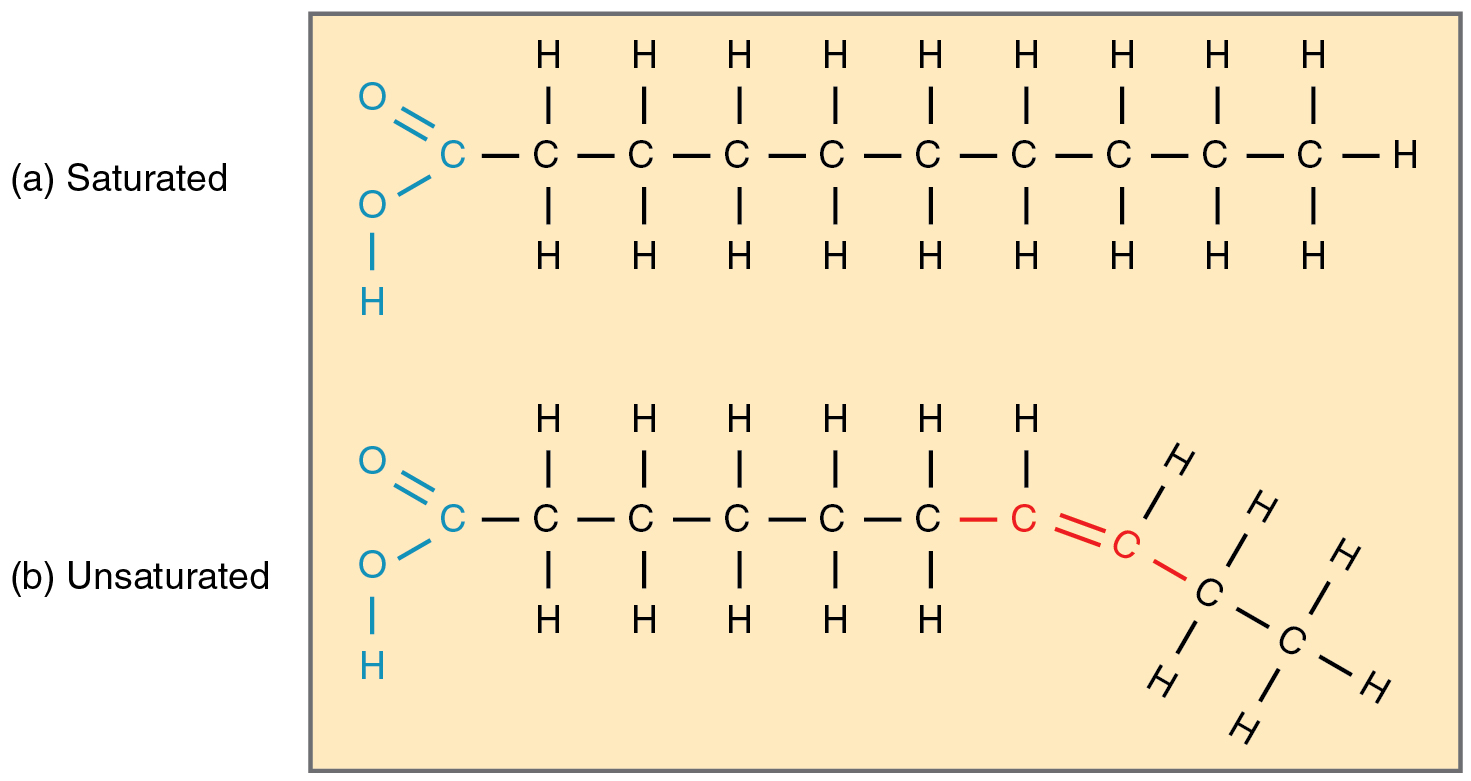
Whereas a weight loss program excessive in saturated fatty acids will increase the danger of coronary heart illness, a weight loss program excessive in unsaturated fatty acids is assumed to cut back the danger. That is very true for the omega-3 unsaturated fatty acids present in cold-water fish akin to salmon. These fatty acids have their first double carbon bond on the third hydrocarbon from the methyl group (known as the omega finish of the molecule).
Lastly, trans fatty acids present in some processed meals, together with some stick and tub margarines, are considered much more dangerous to the guts and blood vessels than saturated fatty acids. Trans fat are created from unsaturated fatty acids (akin to corn oil) when chemically handled to supply partially hydrogenated fat.
As a gaggle, triglycerides are a significant gas supply for the physique. If you find yourself resting or asleep, a majority of the power used to maintain you alive is derived from triglycerides saved in your fats (adipose) tissues. Triglycerides additionally gas lengthy, sluggish bodily exercise akin to gardening or mountain climbing, and contribute a modest share of power for vigorous bodily exercise. Dietary fats additionally assists the absorption and transport of the nonpolar fat-soluble nutritional vitamins A, D, E, and Ok. Moreover, saved physique fats protects and cushions the physique’s bones and inside organs, and acts as insulation to retain physique warmth.
Fatty acids are additionally parts of glycolipids, that are sugar-fat compounds discovered within the cell membrane. Lipoproteins are compounds during which the hydrophobic triglycerides are packaged in protein envelopes for transport in physique fluids.
Phospholipids
As its title suggests, a phospholipid is a bond between the glycerol element of a lipid and a phosphorous molecule. In reality, phospholipids are comparable in construction to triglycerides. Nonetheless, as an alternative of getting three fatty acids, a phospholipid is generated from a diglyceride, a glycerol with simply two fatty acid chains (Figure 2.5.6). The third binding website on the glycerol is taken up by the phosphate group, which in flip is connected to a polar “head” area of the molecule. Recall that triglycerides are nonpolar and hydrophobic. This nonetheless holds for the fatty acid portion of a phospholipid compound. Nonetheless, the top of a phospholipid incorporates prices on the phosphate teams, in addition to on the nitrogen atom. These prices make the phospholipid head hydrophilic. Due to this fact, phospholipids are stated to have hydrophobic tails, containing the impartial fatty acids, hydrophilic heads, the charged phosphate teams, and nitrogen atom.
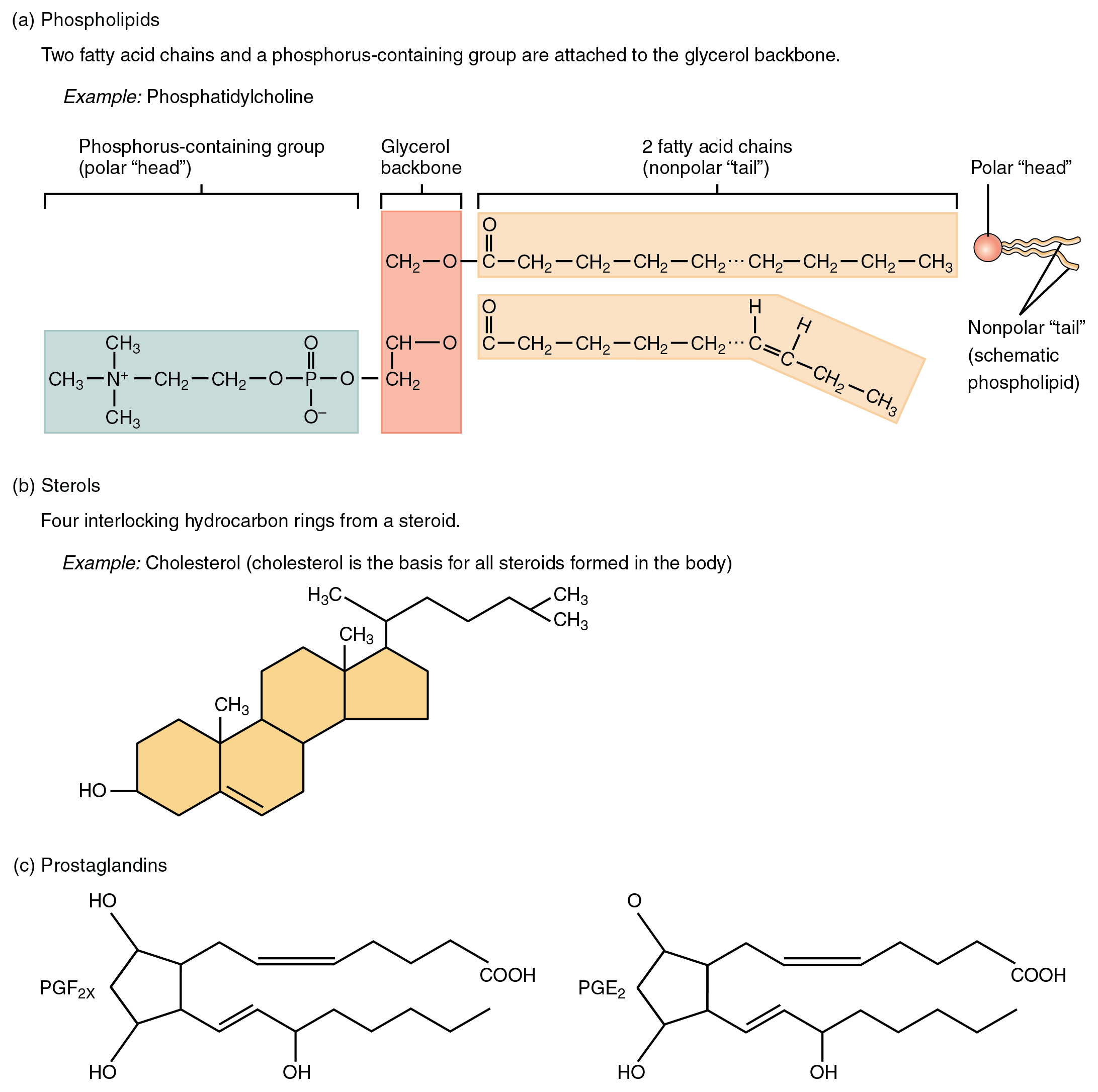
Steroids
A steroid compound (known as a sterol) has as its basis a set of 4 hydrocarbon rings bonded to quite a lot of different atoms and molecules (see Determine 2.5.6b). Though each vegetation and animals synthesize sterols, the kind that makes an important contribution to human construction and performance is ldl cholesterol, which is synthesized by the liver in people and animals and can also be current in most animal-based meals. Like different lipids, ldl cholesterol’s hydrocarbons make it hydrophobic, nevertheless, it has a polar hydroxyl head that’s hydrophilic. Ldl cholesterol is a vital element of bile acids and compounds that assist emulsify dietary fat. In reality, the phrase’s root chole- refers to bile. Ldl cholesterol can also be a constructing block of many hormones, signaling molecules that the physique releases to control processes at distant websites. Lastly, like phospholipids, ldl cholesterol molecules are discovered within the cell membrane, the place their hydrophobic and hydrophilic areas assist regulate the movement of gear into and out of the cell.
Prostaglandins
Like a hormone, a prostaglandin is one in all a gaggle of signaling molecules, however prostaglandins are derived from unsaturated fatty acids (see Figure 2.5.6c). One motive that the omega-3 fatty acids present in fish are helpful is that they stimulate the manufacturing of sure prostaglandins that assist regulate elements of blood strain and irritation, and thereby cut back the danger for coronary heart illness. Prostaglandins additionally sensitize nerves to ache. One class of pain-relieving drugs referred to as nonsteroidal anti-inflammatory medicine (NSAIDs) works by lowering the consequences of prostaglandins.
Proteins
You would possibly affiliate proteins with muscle tissue, however in reality, proteins are essential parts of all tissues and organs. A protein is an natural molecule composed of amino acids linked by peptide bonds. Proteins embrace the keratin within the dermis of pores and skin that protects underlying tissues, and the collagen discovered within the dermis of pores and skin, in bones, and within the meninges that cowl the mind and spinal twine. Proteins are additionally parts of lots of the physique’s purposeful chemical compounds, together with digestive enzymes within the digestive tract, antibodies, the neurotransmitters that neurons use to speak with different cells, and the peptide-based hormones that regulate sure physique capabilities (as an example, progress hormone). Whereas carbohydrates and lipids are composed of hydrocarbons and oxygen, all proteins additionally include nitrogen (N), and plenty of include sulfur (S), along with carbon, hydrogen, and oxygen.
Microstructure of Proteins
Proteins are polymers made up of nitrogen-containing monomers referred to as amino acids. An amino acid is a molecule composed of an amino group and a carboxyl group, along with a variable aspect chain. Simply 20 totally different amino acids contribute to almost all the 1000’s of various proteins necessary in human construction and performance. Physique proteins include a novel mixture of some dozen to some hundred of those 20 amino acid monomers. All 20 of those amino acids share the same construction (Determine 2.5.7). All include a central carbon atom to which the next are bonded:
- a hydrogen atom
- an alkaline (primary) amino group NH2 (see Desk 2.1)
- an acidic carboxyl group COOH (see Desk 2.1)
- a variable group
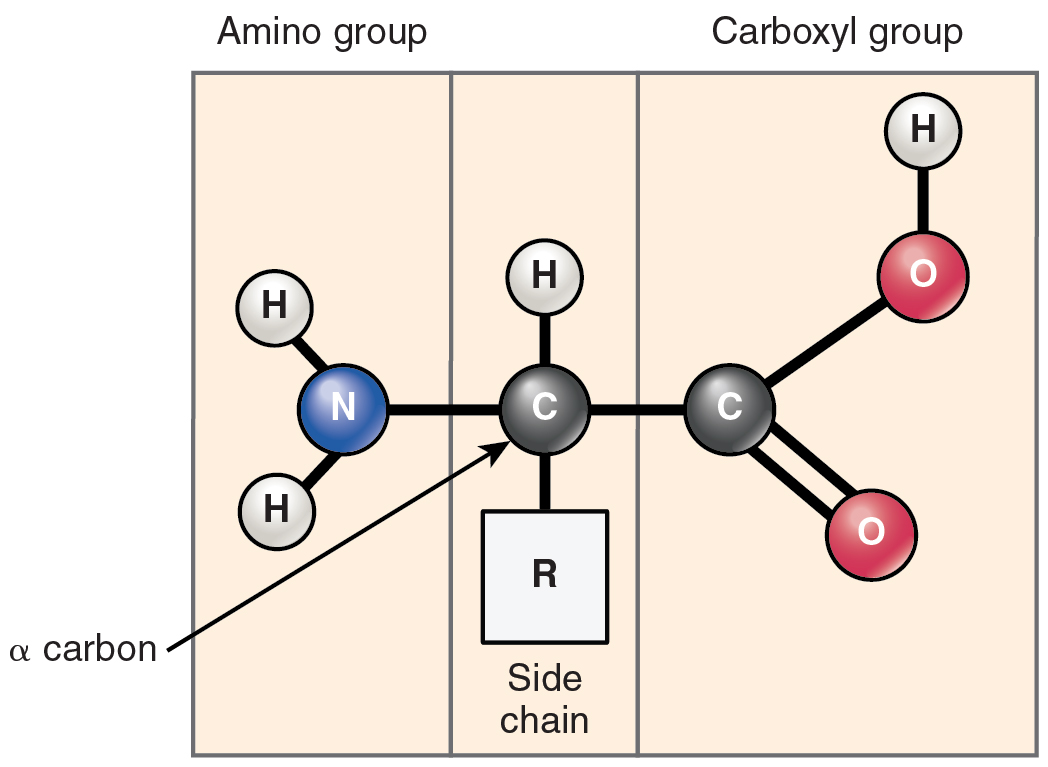
Discover that each one amino acids include each an acid (the carboxyl group) and a base (the amino group) (amine = “nitrogen-containing”). For that reason, they make wonderful buffers, serving to the physique regulate acid–base stability. What distinguishes the 20 amino acids from each other is their variable group, which is known as a aspect chain or an R-group. This group can fluctuate in measurement and could be polar or nonpolar, giving every amino acid its distinctive traits. For instance, the aspect chains of two amino acids—cysteine and methionine—include sulfur. Sulfur doesn’t readily take part in hydrogen bonds, whereas all different amino acids do. This variation influences the way in which that proteins containing cysteine and methionine are assembled.
Amino acids be a part of through dehydration synthesis to kind protein polymers (Determine 2.5.8). The distinctive bond holding amino acids collectively is named a peptide bond. A peptide bond is a covalent bond between two amino acids that’s fashioned by dehydration synthesis. A peptide, in reality, is a really quick chain of amino acids. Strands containing fewer than about 100 amino acids are usually known as polypeptides moderately than proteins.
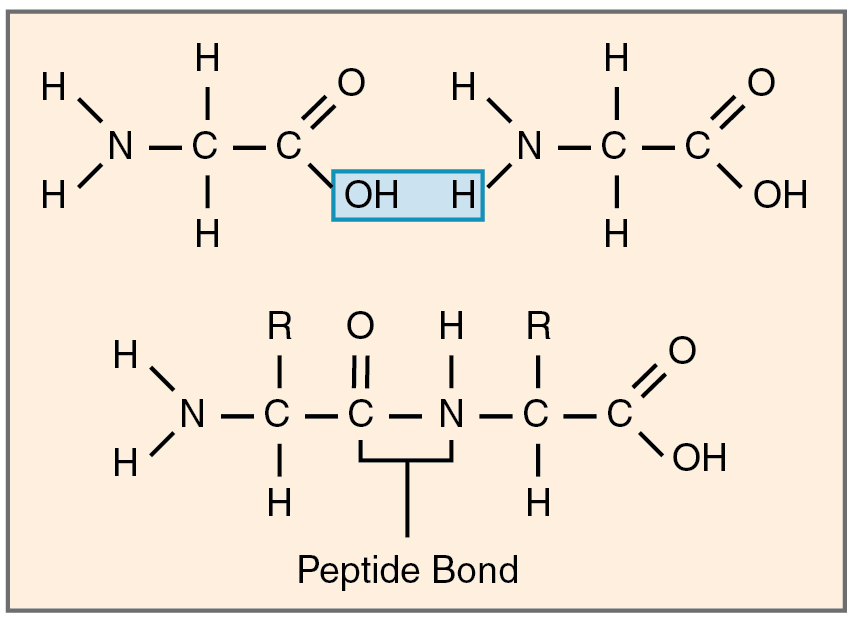
The physique is ready to synthesize a lot of the amino acids from parts of different molecules, nevertheless, 9 can’t be synthesized and should be consumed within the weight loss program. These are often called the important amino acids.
Free amino acids accessible for protein development are stated to reside within the amino acid pool inside cells. Buildings inside cells use these amino acids when assembling proteins. If a specific important amino acid will not be accessible in adequate portions within the amino acid pool, nevertheless, synthesis of proteins containing it may sluggish and even stop.
Form of Proteins
Simply as a fork can’t be used to eat soup and a spoon can’t be used to spear meat, a protein’s form is important to its perform. A protein’s form is set, most essentially, by the sequence of amino acids of which it’s made (Determine 2.5.9a). The sequence is named the first construction of the protein.

Though some polypeptides exist as linear chains, most are twisted or folded into extra complicated secondary constructions that kind when bonding happens between amino acids with totally different properties at totally different areas of the polypeptide. The commonest secondary construction is a spiral referred to as an alpha-helix. Should you have been to take a size of string and easily twist it right into a spiral, it might not maintain the form. Equally, a strand of amino acids couldn’t keep a secure spiral form with out the assistance of hydrogen bonds, which create bridges between totally different areas of the identical strand (see Determine 2.5.9b). Much less generally, a polypeptide chain can kind a beta-pleated sheet, during which hydrogen bonds kind bridges between totally different areas of a single polypeptide that has folded again upon itself, or between two or extra adjoining polypeptide chains.
The secondary construction of proteins additional folds right into a compact three-dimensional form, known as the protein’s tertiary construction (see Determine 2.5.9c). On this configuration, amino acids that had been very distant within the main chain could be introduced fairly shut through hydrogen bonds or, in proteins containing cysteine, through disulfide bonds. A disulfide bond is a covalent bond between sulfur atoms in a polypeptide. Usually, two or extra separate polypeptides bond to kind a fair bigger protein with a quaternary construction (see Figure 2.5.9d). The polypeptide subunits forming a quaternary construction could be equivalent or totally different. As an illustration, hemoglobin, the protein present in purple blood cells consists of 4 tertiary polypeptides, two of that are referred to as alpha chains and two of that are referred to as beta chains.
When they’re uncovered to excessive warmth, acids, bases, and sure different substances, proteins will denature. Denaturation is a change within the construction of a molecule by way of bodily or chemical means. Denatured proteins lose their purposeful form and are not in a position to perform their jobs. An on a regular basis instance of protein denaturation is the curdling of milk when acidic lemon juice is added.
The contribution of the form of a protein to its perform can hardly be exaggerated. For instance, the lengthy, slender form of protein strands that make up muscle tissue is important to their capacity to contract (shorten) and chill out (lengthen). As one other instance, bones include lengthy threads of a protein referred to as collagen that acts as scaffolding upon which bone minerals are deposited. These elongated proteins, referred to as fibrous proteins, are sturdy and sturdy and sometimes hydrophobic.
In distinction, globular proteins are globes or spheres that are typically extremely reactive and are hydrophilic. The hemoglobin proteins packed into purple blood cells are an instance (see Figure 2.59d), nevertheless, globular proteins are plentiful all through the physique, enjoying essential roles in most physique capabilities. Enzymes, launched earlier as protein catalysts, are examples of this. The following part takes a more in-depth have a look at the motion of enzymes.
Proteins Perform as Enzymes
Should you have been making an attempt to sort a paper, and each time you hit a key in your laptop computer there was a delay of six or seven minutes earlier than you bought a response, you’d most likely get a brand new laptop computer. In the same approach, with out enzymes to catalyze chemical reactions, the human physique can be nonfunctional. It capabilities solely as a result of enzymes perform.
Enzymatic reactions—chemical reactions catalyzed by enzymes—start when substrates bind to the enzyme. A substrate is a reactant in an enzymatic response. This happens on areas of the enzyme often called lively websites (Determine 2.5.10). Any given enzyme catalyzes only one sort of chemical response. This attribute, referred to as specificity, is because of the truth that a substrate with a specific form and electrical cost can bind solely to an lively website similar to that substrate.
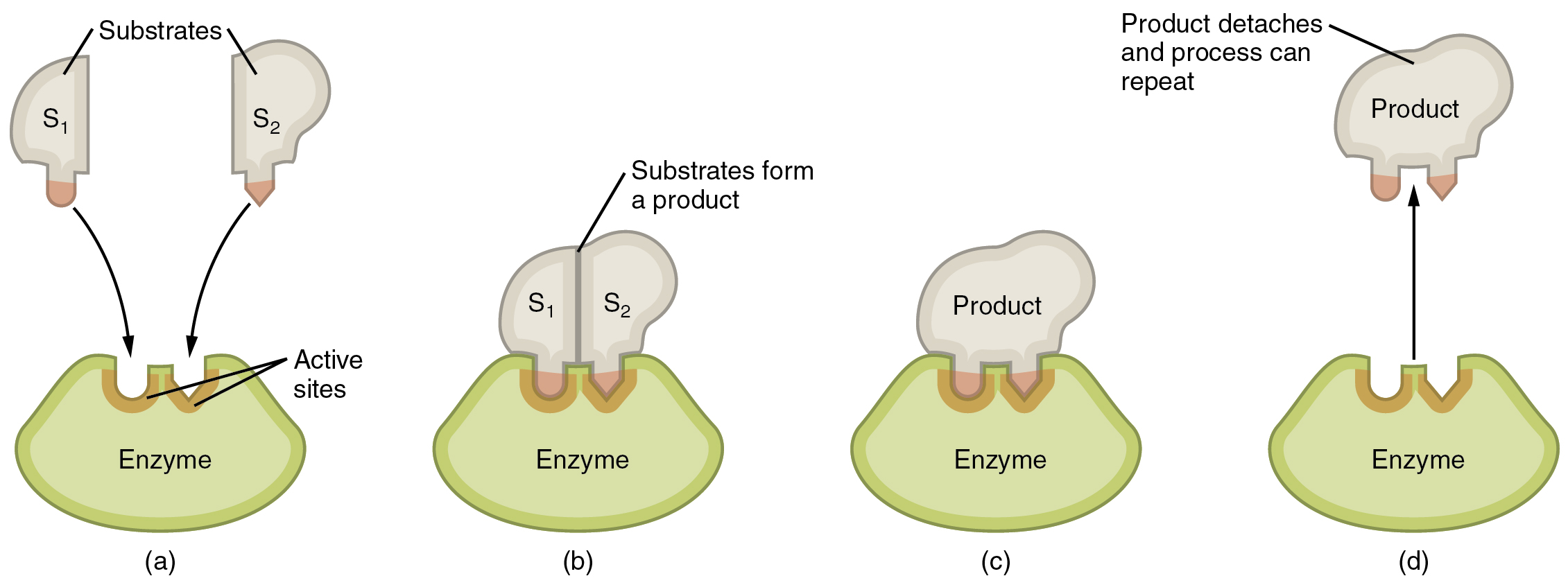
Binding of a substrate produces an enzyme–substrate complicated. It’s probably that enzymes velocity up chemical reactions partially as a result of the enzyme–substrate complicated undergoes a set of momentary and reversible adjustments that trigger the substrates to be oriented towards one another in an optimum place to facilitate their interplay. This promotes elevated response velocity. The enzyme then releases the product(s), and resumes its authentic form. The enzyme is then free to interact within the course of once more, and can achieve this so long as substrate stays.
Different Features of Proteins
Ads for protein bars, powders, and shakes all say that protein is necessary in constructing, repairing, and sustaining muscle tissue, however the fact is that proteins contribute to all physique tissues, from the pores and skin to the mind cells. Additionally, sure proteins act as hormones and chemical messengers that assist regulate physique capabilities. For instance, progress hormone is necessary for skeletal progress, amongst different roles.
As was famous earlier, the essential and acidic parts allow proteins to perform as buffers in sustaining acid–base stability, however additionally they assist regulate fluid–electrolyte stability. Proteins appeal to fluid, and a wholesome focus of proteins within the blood, the cells, and the areas between cells helps guarantee a stability of fluids in these varied “compartments.” Furthermore, proteins within the cell membrane assist to move electrolytes out and in of the cell, conserving these ions in a wholesome stability. Like lipids, proteins can bind with carbohydrates. They’ll thereby produce glycoproteins or proteoglycans, each of which have many capabilities within the physique.
The physique can use proteins for power when carbohydrate and fats consumption is insufficient, and shops of glycogen and adipose tissue change into depleted. Nonetheless, since there is no such thing as a storage website for protein besides purposeful tissues, utilizing protein for power causes tissue breakdown and ends in physique losing.
Nucleotides
The fourth sort of natural compound necessary to human construction and performance are the nucleotides (Determine 2.5.11). A nucleotide is one in all a category of natural compounds composed of three subunits:
- a number of phosphate teams
- a pentose sugar: both deoxyribose or ribose
- a nitrogen-containing base: adenine, cytosine, guanine, thymine, or uracil
Nucleotides could be assembled into nucleic acids (DNA or RNA) or the power compound adenosine triphosphate.
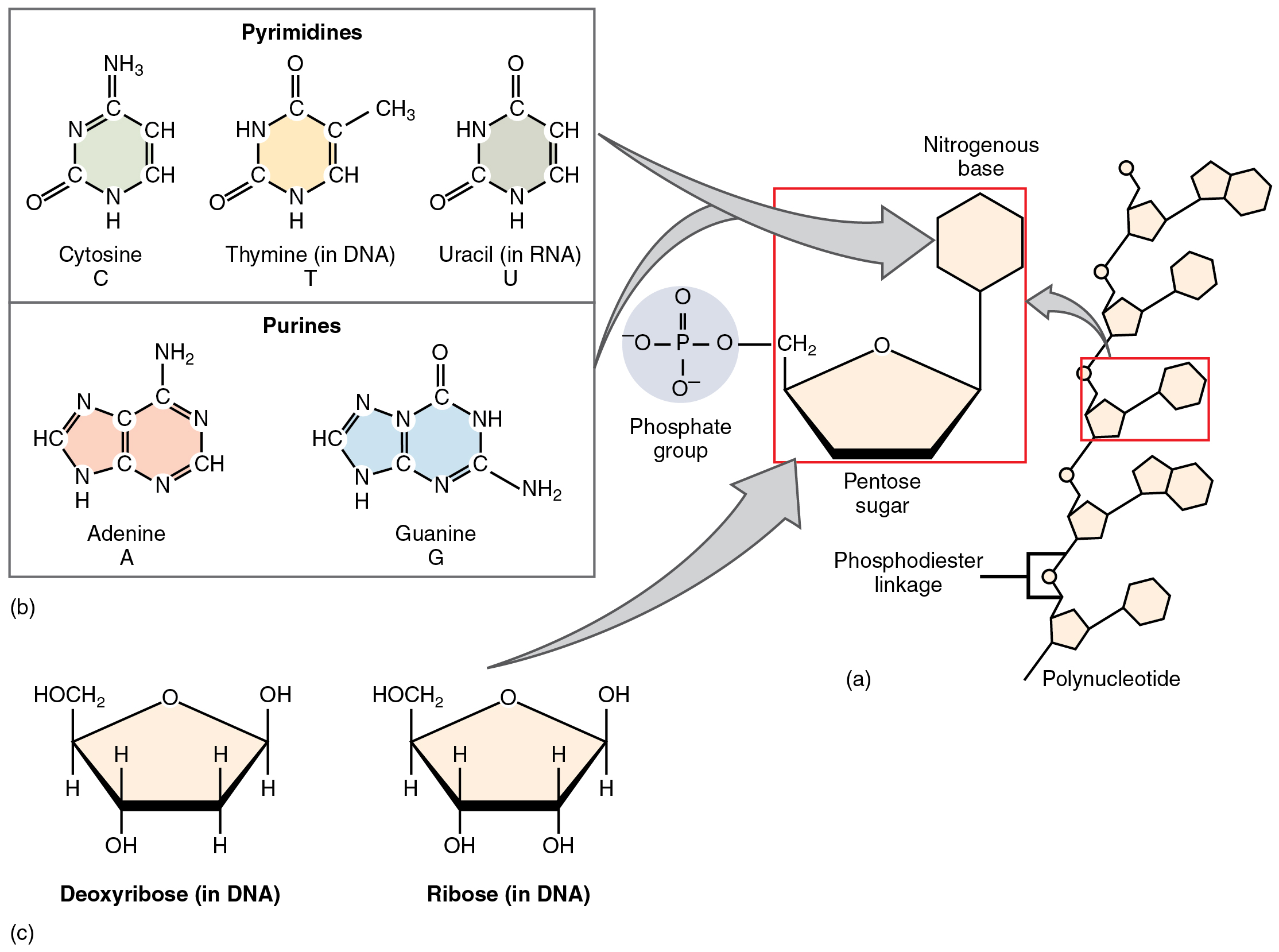
Nucleic Acids
The nucleic acids differ of their sort of pentose sugar. Deoxyribonucleic acid (DNA) is nucleotide that shops genetic data. DNA incorporates deoxyribose (so-called as a result of it has one much less atom of oxygen than ribose) plus one phosphate group and one nitrogen-containing base. The “decisions” of base for DNA are adenine, cytosine, guanine, and thymine. Ribonucleic acid (RNA) is a ribose-containing nucleotide that helps manifest the genetic code as protein. RNA incorporates ribose, one phosphate group, and one nitrogen-containing base, however the “decisions” of base for RNA are adenine, cytosine, guanine, and uracil.
The nitrogen-containing bases adenine and guanine are labeled as purines. A purine is a nitrogen-containing molecule with a double ring construction, which accommodates a number of nitrogen atoms. The bases cytosine, thymine (present in DNA solely) and uracil (present in RNA solely) are pyramidines. A pyramidine is a nitrogen-containing base with a single ring construction
Bonds fashioned by dehydration synthesis between the pentose sugar of 1 nucleic acid monomer and the phosphate group of one other kind a “spine,” from which the parts’ nitrogen-containing bases protrude. In DNA, two such backbones connect at their protruding bases through hydrogen bonds. These twist to kind a form often called a double helix (Determine 2.5.12). The sequence of nitrogen-containing bases inside a strand of DNA kind the genes that act as a molecular code instructing cells within the meeting of amino acids into proteins. People have virtually 22,000 genes of their DNA, locked up within the 46 chromosomes contained in the nucleus of every cell (besides purple blood cells which lose their nuclei throughout improvement). These genes carry the genetic code to construct one’s physique, and are distinctive for every particular person besides equivalent twins.

In distinction, RNA consists of a single strand of sugar-phosphate spine studded with bases. Messenger RNA (mRNA) is created throughout protein synthesis to hold the genetic directions from the DNA to the cell’s protein manufacturing vegetation within the cytoplasm and the ribosomes.
Adenosine Triphosphate
The nucleotide adenosine triphosphate (ATP), consists of a ribose sugar, an adenine base, and three phosphate teams (Determine 2.5.13). ATP is classed as a excessive power compound as a result of the 2 covalent bonds linking its three phosphates retailer a big quantity of potential power. Within the physique, the power launched from these excessive power bonds helps gas the physique’s actions, from muscle contraction to the transport of gear out and in of cells to anabolic chemical reactions.
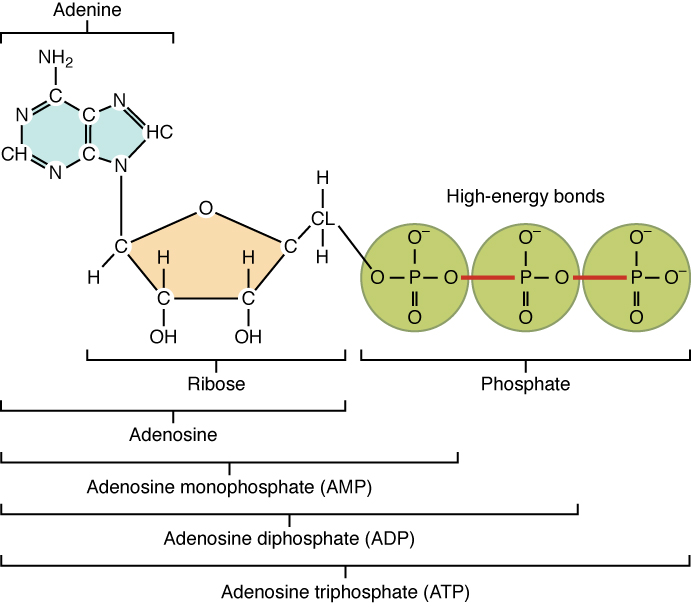
When a phosphate group is cleaved from ATP, the merchandise are adenosine diphosphate (ADP) and inorganic phosphate (Pi). This hydrolysis response could be written:
ATP + H2O → ADP + Pi + power
Elimination of a second phosphate leaves adenosine monophosphate (AMP) and two phosphate teams. Once more, these reactions additionally liberate the power that had been saved within the phosphate-phosphate bonds. They’re reversible, too, as when ADP undergoes phosphorylation. Phosphorylation is the addition of a phosphate group to an natural compound, on this case, leading to ATP. In such circumstances, the identical stage of power that had been launched throughout hydrolysis should be reinvested to energy dehydration synthesis.
Cells may switch a phosphate group from ATP to a different natural compound. For instance, when glucose first enters a cell, a phosphate group is transferred from ATP, forming glucose phosphate (C6H12O6—P) and ADP. As soon as glucose is phosphorylated on this approach, it may be saved as glycogen or metabolized for speedy power.
Chapter Overview
Natural compounds important to human functioning embrace carbohydrates, lipids, proteins, and nucleotides. These compounds are stated to be natural as a result of they include each carbon and hydrogen. Carbon atoms in natural compounds readily share electrons with hydrogen and different atoms, normally oxygen, and typically nitrogen. Carbon atoms additionally might bond with a number of purposeful teams akin to carboxyls, hydroxyls, aminos, or phosphates. Monomers are single models of natural compounds. They bond by dehydration synthesis to kind polymers, which may in flip be damaged by hydrolysis.
Carbohydrate compounds present important physique gas. Their structural kinds embrace monosaccharides akin to glucose, disaccharides akin to lactose, and polysaccharides, together with starches (polymers of glucose), glycogen (the storage type of glucose), and fiber. All physique cells can use glucose for gas. It’s transformed through an oxidation-reduction response to ATP.
Lipids are hydrophobic compounds that present physique gas and are necessary parts of many organic compounds. Triglycerides are probably the most plentiful lipid within the physique, and are composed of a glycerol spine connected to a few fatty acid chains. Phospholipids are compounds composed of a diglyceride with a phosphate group connected on the molecule’s head. The result’s a molecule with polar and nonpolar areas. Steroids are lipids fashioned of 4 hydrocarbon rings. Crucial is ldl cholesterol. Prostaglandins are signaling molecules derived from unsaturated fatty acids.
Proteins are essential parts of all physique tissues. They’re made up of monomers referred to as amino acids, which include nitrogen, joined by peptide bonds. Protein form is essential to its perform. Most physique proteins are globular. An instance is enzymes, which catalyze chemical reactions.
Nucleotides are compounds with three constructing blocks: a number of phosphate teams, a pentose sugar, and a nitrogen-containing base. DNA and RNA are nucleic acids that perform in protein synthesis. ATP is the physique’s basic molecule of power switch. Elimination or addition of phosphates releases or invests power.